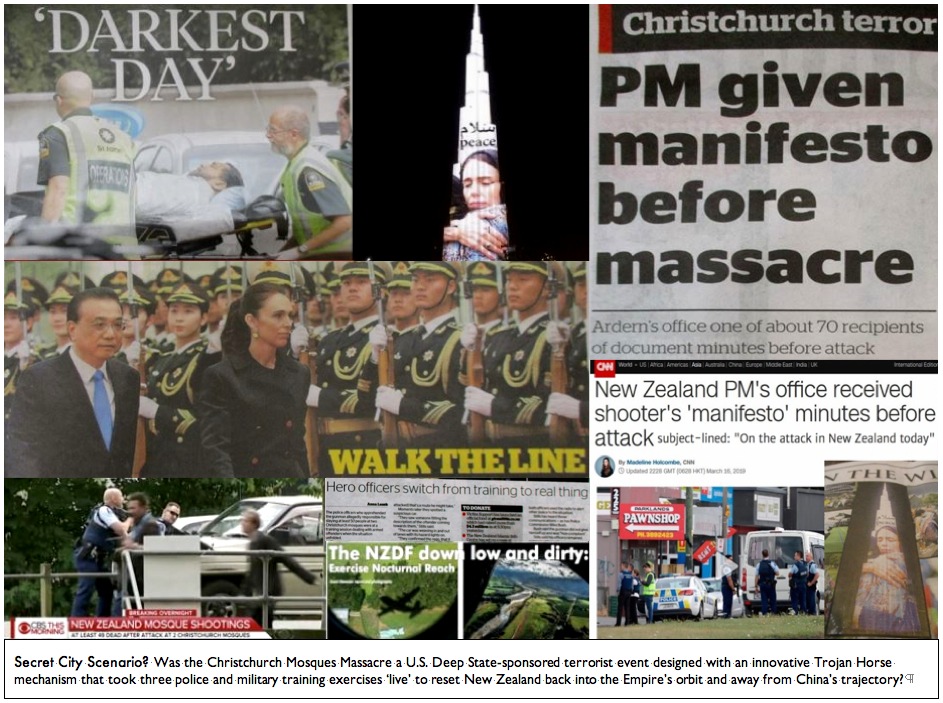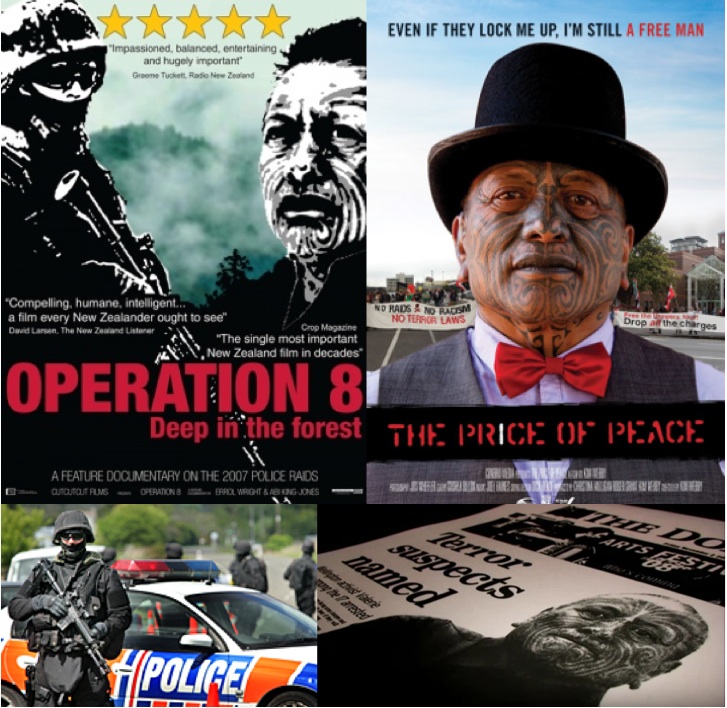

Tame Iti as the Crown’s new scapegoat to resolve multiple crises
The Police dawn raids – code-named Operation Eight – of 15 October 2007 that were inflicted at several locations across the imaginatively-named North Island of New Zealand are explored here as a psy-op, or psychological warfare.
Tūhoe’s aspirations to regain land stolen by the Crown were undermined by Operation Eight and the subsequent vexatious criminal proceedings.
The key finding of this investigation is that New Zealand’s Deep State deftly scripted a successful B-Grade multi-season News Special psy-op – Operation Eight – that re-framed Te Urewera wilderness as a place where para-military terrorism training camps were being conducted. The vicious intention in this re-framing exercise was to shift the political center of gravity away from the very real possibility that Tūhoe would gain substantive sovereignty through the return of their native estate. To re-frame Te Urewera wilderness with a terror news frame, a perennial fixture in the Neo-Colonial Realm of New Zealand was activated by the national security state apparatus through the news media, the courts and the executive branch of government: the propagandist scapegoat mechanism.
This vicious psychological projection demonstrates that New Zealand’s Deep State had applied the ‘lessons learned’ from the collapse of their previous multi-season psy-op news special in mid-2007 – the persecution of Algerian-born academic, Ahmed Zaoui, whom the state had considered a terrorist threat for nearly five years. Because the N.Z. Deep State avoided publicly disclosing that Zaoui had been framed as a terrorist guerilla leader by the Algerian secret service, whom inserted this malicious legend into the French, Belgium and Swiss intelligence agencies – the Crown Police were able to re-script this violent revolutionary idea to cast Tame Iti with a terrorist guerilla legend. Because Tūhoe had a strong case for a return of their ancestral lands, especially as the iwi never signed the Treaty, the Crown pursued a pys-op strategy to derail the tribe’s objective to avoid conferring native title to the Urewera wilderness. Such an outcome would have been catastrophic for the Crown, because every other iwi and hapū would have demanded a return of mountains, lakes and rivers, unencumbered by Crown jurisdiction – regardless of whether they had settled or not.
Therefore, N.Z.’s Deep State displayed a comprehension of statecraft in the form of low-grade psychological warfare designed to achieve the same result as the NATO states low-grade war using false flag terrorism, wherein communist groups were blamed for bombings to shift the political center of gravity away from socialism and associating peace and freedom with liberal democracy that masks stealthy Neo-Colonial Capitalism. In the case of Operation Eight, a succession faction of Tuhoe were associated with a radical, violent ‘fringe group’ because their most visible personality – Tame Iti – was cast with the guerilla terrorist legend by the Deep State faction of N.Z.’s national security, whom needed to justify their existence.
By Steve ‘Snoopman’ Edwards
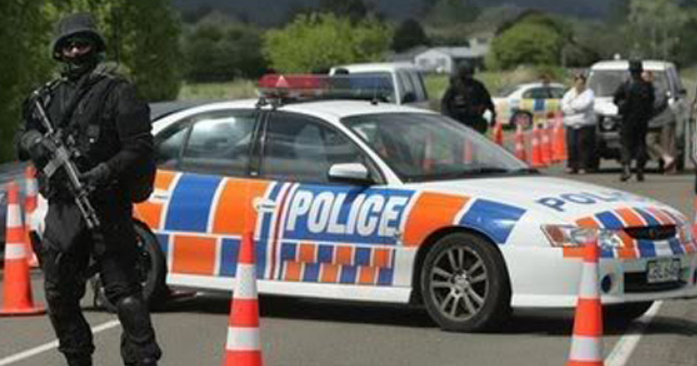
Tame Iti as the Crown’s new ‘War on Terror’ scapegoat
The ‘Operation Eight’ police raids of October 15 2007 unleashed 300 police officers breaking into and searching 60 homes around New Zealand, including in Wellington, Auckland and a small rural community, Rūātoki, that is comprised of mostly Māori of the Tūhoe iwi. Rūātoki bore the brunt of Police intimidation. It was locked down by masked heavily armed members of the Police Armed Offenders Squad (AOS) and the Northern Special Tactics Group (STG), who detained people at gunpoint, including men, women and children who were not even suspects. Police arrested 17 indigenous, anarchist, environmental and anti-war activists and took into custody people from Tūhoe, Te Atiawa, Maniapoto and Ngā Puhi, along with a few token Pākehā to share in the Deep State’s vindictive need for politically correct subterfuge.
Only two people in Rūātoki were arrested with Terrorism charges. Not two hundred.
Two.
Those raids, which caused loss to Tūhoe’s credibility – as intended – followed Tame Iti’s misguided call for an ‘uprising’ at the Parihaka International Peace and Music Festival. To an audience of about 300 people in the political forum tent, Iti justified his call for an uprising because the New Zealand Crown was returning little of the stolen and swindled lands to Māori in the Treaty Settlements and it was blocking Māori from forming self-determining communities with fiat cheques for a fraction of the property lost.
The malicious intention was to undermine Tūhoe aspirations for sovereignty, besmirch left-wing causes, and address an imminent threat to the Police-Intelligence-Security-State apparatus – the collapse of its justification for more Police State powers in the months prior to the raids.
Following the collapse of the state’s case against political asylum seeker Ahmed Zaoui – who had been framed as a terrorist by Algeria’s former head of intelligence and counter-espionage for northern Europe – New Zealand’s Deep State was faced with a crisis of legitimacy in seeking new Police State powers under consideration by parliament at the time.
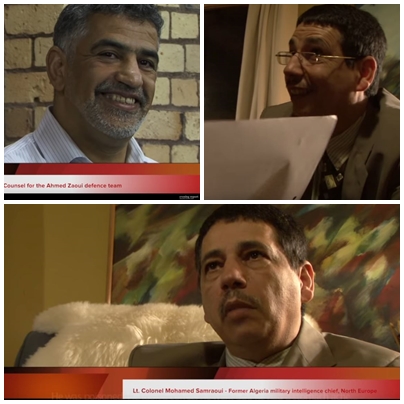
By casting activist-artist Tame Iti as a terrorist guerilla leader with a nationwide network, the National Security State essentially transposed the same legend that had been created by Algeria’s equivalent to the CIA, the Département du Renseignement et de la Sécurité – or DRS – onto Tūhoe’s most visible face to scapegoat.
It turns out, N.Z.’s National Security State suppressed the mid-2007 testimony of former-DRS agent Lieutenant Colonel Mohamed Samraoui, who supplied evidence to New Zealand’s Inspector General for Security & Intelligence, Justice Paul Neazor, that he had framed Algerian academic and asylum seeker Ahmed Zaoui as a terrorist – as journalist Sewlyn Manning proved in his 2012 documentary, Behind the Shroud: Juxtapositioning Truth, Intelligence and Tradecraft. New Zealand’s Security Intelligence Service (SIS) had ‘relied’ on planted intelligence from Belgium, France and Switzerland. These were the same intelligence agencies involved in the 1985 Rainbow Warrior Bombing – which was inflicted five years before Operation Gladio was exposed (and ultimately was proven by Swiss historian Daniel Ganser to have been a three-decade reign of terror mete-out by every NATO country on their own civilian populations to shift the political centre of gravity away from socialist governments by blaming left-wing communists).
Instead of fessing up to the public, SIS Director Warren Tucker issued a deceptive communiqué on September 13th 2007 insinuating that Zaoui participated in and led terrorist networks in France and Belgium, and claimed he was deported from Switzerland for making statements to incite violence. With this deceitful, malicious communiqué spread over the news wires, the SIS director was telegraphing the direction the National Security State was heading. The Crown faced a looming catastrophic collapse of its sole sovereign power because if Tūhoe had gained the sovereign Māori title to the Ureweras, the state would have likely been overwhelmed with demands from other iwi and hapu for the return of tracts of land, regardless of whether or not they had signed the 1840 Waitangi Treaty or had already settled. Therefore, because the collapse of the Clark Ministry’s efforts to bring the anti-Muslim Global War on Terror zeitgeist to New Zealand converged with a looming governance crisis, the New Zealand Crown fell back to its perennial default position: casting Māori as the enemy of the state since 1840.
This crisis of legitimacy converged with the Crown’s need to lower expectations among Tūhoe about the return of lands stolen in the process of state formation.
In the background were private investigator firms, such as Thompson and Clark, police informant Rob Gilchrist and big business groups – whose roles, motives and links remained beyond the investigation of the judiciary, the Solicitor’s General and parliamentary lawmakers.
However, the Police pursued the raids despite finding that there was no terror plot or imminent threat. The Police even allowed National Party leader John Key and Finance Minister Michael Cullen to visit Tūhoe country at events where Tame Iti was one of the hosts.
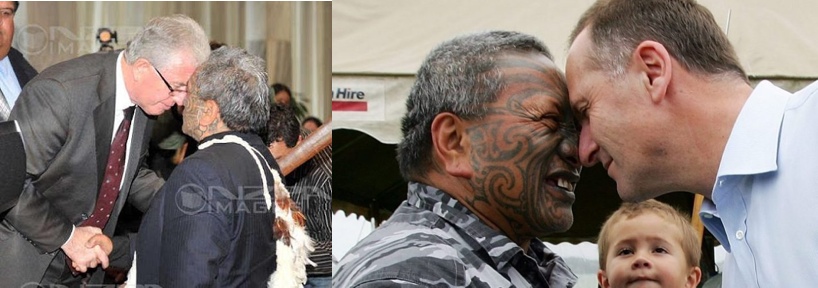
The documentary Operation 8: Deep in the Forest[1] showed that the militarized police raids on Rūātoki, as well as environmentalists, social justice activists and permaculturalists in Wellington and Christchurch and Taupo – were Deep State code for a ‘Go Live’ to attack Māori, left-wing causes and progressive ideas about living beyond the control of the Neo-Colonialist state. For their film, directors Errol Wright and Abi King-Jones recruited numerous experts that backed up the claims of the arrested, that they were not planning terrorism. Those experts – including a former undercover police agent, Patrick O’Brien, former Police Inspector Ross Meurant, investigative journalist Nicky Hager, indigenous rights lawyer Annette Sykes, Council for Civil Liberties lawyer Barry Wilson, Otago University media studies lecturer Dr Vijay Devadas, and Auckland law professor Jane Kelsey – built a picture of the New Zealand Police framing innocent people.
According to the expert interviewees, the police and intelligence apparatus construct false intelligence assessments to produce convictions that justify the state’s Police-Intelligence-Spy-Surveillance complex and achieve political objectives, through the exploitation of spies, undercover agents, and state and private surveillance. Or, as then-Police Commissioner Howard Broad said at the time, “a full range of capabilities”, were deployed, without any sense of the irony that his name lent to the situation wherein he explained how the operations went forward by drawing upon the national security state’s broad apparatus.
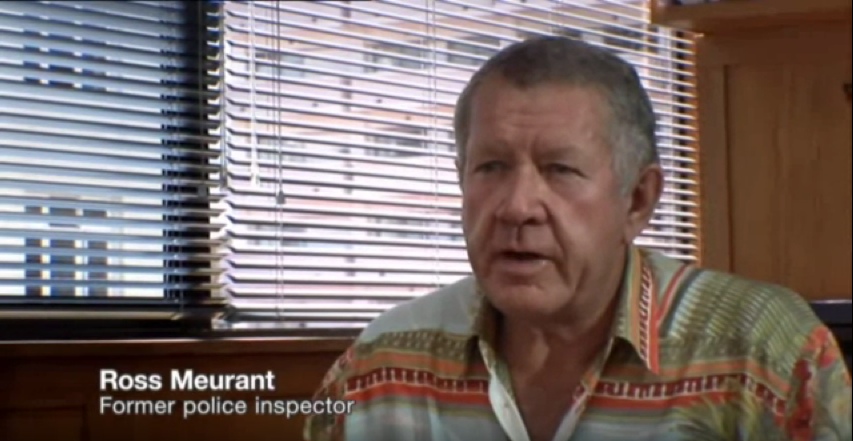
In the Errol Wright and Abi King-Jones’ documentary, Operation 8: Deep in the Forest, former Police Inspector Ross Meurant likened the Police Force to a forest with paranoid elite Police squads that frequently construct cases for prosecution based on “bullshit” deductions from deep in that forest.
The primary objective for the deployment of the scape-goat mechanism was to de-risk Tūhoe’s lawful right to re-acquire the customary Native Estate of Te Urewera, cause division among Tūhoe ahead of negotiating with the Crown, and to inflict stresses on its capacity to win substantive sovereignty over other former Tūhoe territory. This objective, along with a reassertion of state dominance, was achieved – despite any rhetoric to the contrary – as I shall show. The key perpetrators have been left to remain at large, thereby showing that the Crown condones criminal conspiracies that defend its power to remain the sole sovereign protector for the Neo-Colonial Oligarchy, chief regulator of native affairs and their strategic resources.
Deep State Easter Bunnies, Droppings & Easter Eggs
This exquisite example of a Neo-Colonial Deep State plot came packaged with Easter Bunnies, planted ‘Easter Eggs’, and a shiny, brightly-coloured tin-foil conspiracy wrapping that became more crinkled as the facts and evidence were scrutinized.
These packaged elements were embedded as the events unfolded as the key Deep State actors posted themselves as hostages to signal they were advancing the game together – in accordance with game theory – as I laid out in “Psy-warfare from Zaoui to Iti to Dotcom: Introducing the N.Z. Deep State’s multi-season news specials”.[2] These Easter Eggs involved scripting, improvising and recalibrating events with encoded symbolism, such as riffs off dystopian movies and novels, the casting of characters whose names epitomized their roles, and the deployment of the prime number 13 – that made cameo appearances as the recidivist character Thirteen and its cloned selves. The planting of Thirteen and its multiples as mundane data into events, signifies the presence of an oligarchic Brotherhood that are advancing a game together – as weird as it sounds.[3]
However, like all criminal plots, not everything went according to plan – as I shall show.
In such circumstances, the Deep State’s Easter Bunnies shit themselves, leave a trail of bunny droppings that lead to their rabbit holes, and down into the Deep States’ rabbit warrens.
The ‘Operation Eight’ police raids of October 15 2007 unleashed 300 police officers breaking into and searching 60 homes around New Zealand, including in Wellington, Auckland and a small rural community named Rūātoki that is comprised of mostly Māori of the Tūhoe iwi. Rūātoki bore the brunt of Police intimidation and was locked down by masked heavily armed members of the Police Armed Offenders Squad (AOS) and the Northern Special Tactics Group (STG), who detained people at gunpoint, including men, women and children who were not even suspects. Police arrested 18 indigenous, anarchist, environmental and anti-war activists and took into custody people from Tūhoe, Te Atiawa, Maniapoto and Ngā Puhi, along with a few token Pākehā to share in the Deep State’s vindictive need for politically correct subterfuge.
Only two people in Rūātoki were arrested with Terrorism charges. Not two hundred.
Two.
Several of those arrested were kept locked up until after the Solicitor-General David Collins declined permission to allow the Crown prosecutions to proceed under the Terrorism Suppression Act due to the lack of evidence, and advised the media to report with caution. Solicitor-General Collins’ announcement was on 8 November 2007, was a serious blow to the credibility of the Crown Police case because it immediately created the impression that the raids had been over-the-top. Several of the accused were not granted bail until November 12, including Tame Iti, meaning the Police had a full three weeks to conduct a malicious psy-op on the population while the accused were prevented from providing a counter-narrative by speaking to the news media.
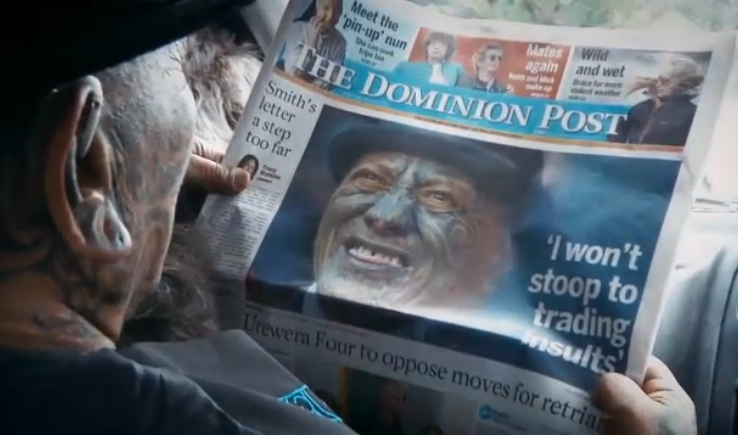
On 9 December 2010, or more than three years after the Operation Eight raids, Justice Helen Winkelmann denied a trial by jury for 15 of the 18 defendants. A three-month trial by judge was set to start in May 31 2011 – brought forward so it did not lash with the Rugby World Cup – requiring the accused to move to Auckland. Outrageously, Judge Winkelmann placed a suppression order over this move for a judge-only trial denying the Establishment News or independent media and others to report:

This judgment is not to be published (including any commentary, summary or description of it) in news media or on internet or other publicly accessible database or otherwise disseminated to the public until final disposition of trial or further order of the court.[4] – Justice Helen Winkelmann
On April Fools’ Day in 2011, liberal conservative business reporter Fran O’Sullivan weighed in with a critical article headlined, “Protect our basic right to trial by jury” in The New Zealand Herald.[5] O’ Sullivan stated cuttingly:
It has been a long time since former police commissioner Howard Broad called showtime and sent his officers into Tuhoe territory to hunt out those he believed were planning terrorist attacks. The fact that the Urewera 18 are not still behind bars suggests the authorities do not seriously believe any of them pose an immediate threat to public safety.
O’ Sullivan over-stated that the denial for a trial by jury for the ‘Urewera 18’ was “a major offence to New Zealand’s proud human rights record” – since she neglected to mention the bits about how Tūhoe lost large chunks of its ‘land parcels’. However, it was simultaneously disturbing and hilarious to find that such scathing criticism fell to a liberal conservative business reporter, who said that New Zealand:
“runs the risk of being set on the path to Star Chamber hearings, where any activist facing serious charges will essentially be subject to a secret trial.”
Star Chamber hearing were an English Court of Law in the Palace of Westminster that existed between the late 15th to mid-17th century and were supposedly established to hear proceedings of high profile people to ensure a fair trial. But, the Star Chamber devolved into a den for enabling political and social suppression. Therefore, O’ Sullivan’s scathing criticism was at least akin to brief moment where a torch was shone down a Deep State rabbit hole.
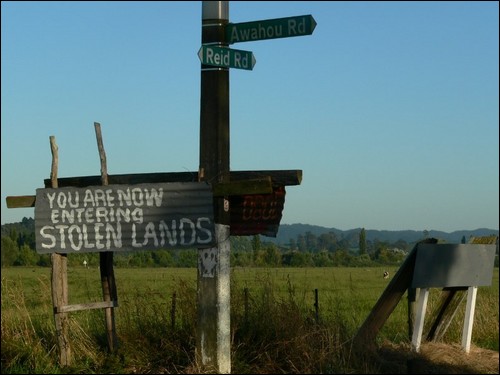
Amid these outrages, one of the accused, the hilariously sharp-witted Tuhoe Lambert died on July 8 2011 waiting for the trial, which was delayed – in part – because the case was primarily a psy-warfare News Special that would have been competing for news audience attention amid the Rugby World Cup. And partly because “patches” to law to authorize the Crown to retrospectively exploit Police evidence gained through illegal search and surveillance of private property, especially video and audio recordings.
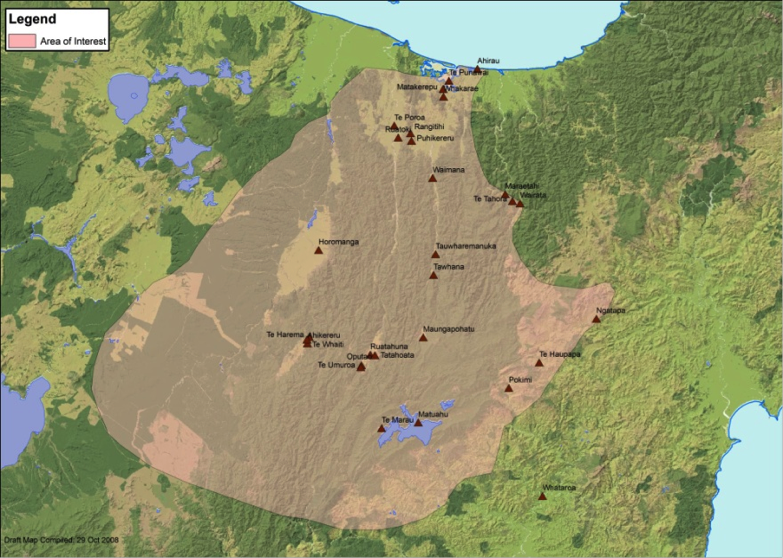
On 6 September 2011, charges against 13 of the 18 accused were dropped. The Crown dropped charges against: Ira Bailey, Marama Mayrick, Rawiri Iti, Omar Hamed, Raunatiri Hunt, Jamie Lockett, Watene McClutchie, Tekaumarua Wharepouri, Moana Winitana, Maraki Teepa, Phillip Purewa, Trudi Paraha and Valerie Morse. After a failed attempt in the Supreme Court to have the case acquitted, the Crown was forced to hold a trial by jury. In October 2011, the Video Camera Surveillance (Temporary Measures) Act 2011 was passed under urgency to provide a temporary period to enable Parliament to move with all deliberate speed to pass its more encompassing Search and Surveillance Bill.[6] This Video Camera Surveillance act was needed to allow judges to retrospectively view footage that the Police had gained illegally through the installment of recording devices on private property for the Urewera Four trial and other cases – in breach of the Evidence Act. In his sarcastic opinion piece published on 23 September 2011, Queen’s Counsel lawyer Dr. Rodney Harrison, who had lead the defence of Ahmed Zaoui and had also advocated for Tame Iti and other co-accused in the Supreme Court, said of the move to rush through the Video Camera Surveillance Bill:
A quick quiz: name one other so-called democracy that would respond to a botched police operation involving deliberate and prolonged police illegality, by immediately passing validating legislation with retrospective effect? No? I thought not.[7]
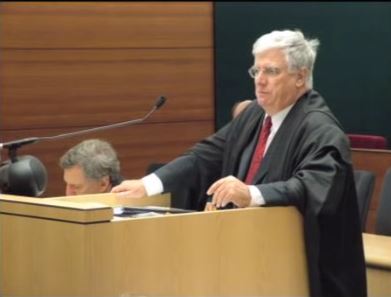
Dr. Rodney Harrison QC added that the New Zealand Government’s obligations were not to legislate human rights violations out of existence andwere therefore, breaching its domestic and international law obligations.
The case that eventuated against the ‘Urewera Four’ – THE QUEEN v TAME WAIRERE ITI, TE RANGIKAIWHIRIA KEMARA, URS PETER SIGNER & EMILY FELICITY BAILEY – was presided over by only one judge, which commenced on February 13th 2012, signalling that the Deep State Brotherhood that dominates New Zealand were advancing the game together, by the choice of date February the 13th.
This, I contend, was why charges against 13 of the 18 accused were dropped on 6 September 2011, rather than dropping the whole B-Grade framing psy-op.
In the ‘Urewera Four Trial’, it was found again that Police knew that no terrorism planning had taken place and that there was no immediate threat. Justice Hansen remarked in a paternalistic tone that violent means to achieve the laudable ends is not justifiable.
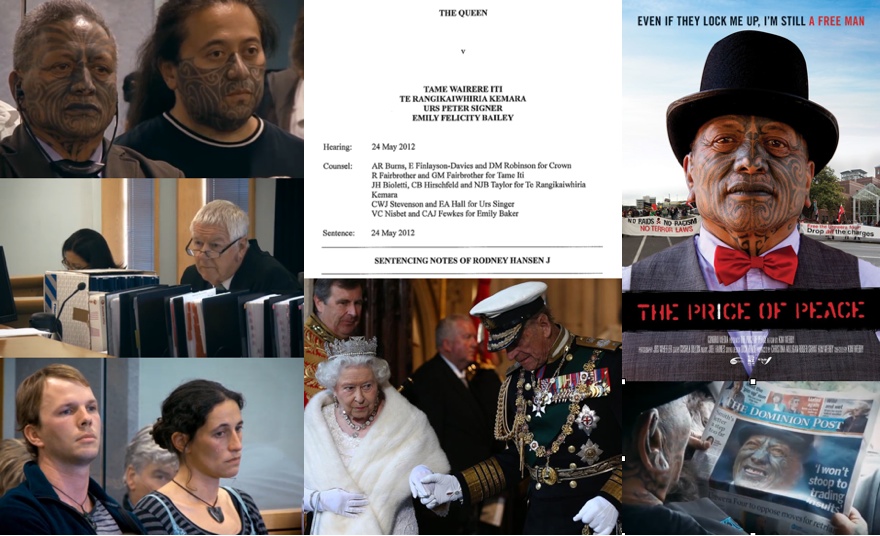
When Operation Eight was terminated, seventeen firearms were found in Rūātoki. That’s isn’t unusual in a country where hunting is a staple feature of rural communities. In total, 26 firearms were found in Rūātoki, Auckland, Wellington and Whakatāne, including semi-automatic weapons and shotguns. By March 20 2012, the jury was unable to reach a verdict on the charges of participation in a criminal group. On 5 April 2012, the Search and Surveillance Act finally received Royal Accent, after it had been introduced in 2009. On May 9 2012, Justice Brewer granted a ‘stay of proceedings’ on the charge of participation in an organised criminal group, meaning the four would not be retried.
Despite these acknowledged facts, the High Court Justice Rodney Hansen sentenced Tame Iti and co-defendant Te Rangikaiwhiria Kemara for two and a half years jail-time, and Urs Signer and Emily Bailey for nine months home detention at Parihaka, ironically, for firearms possession on 24 May 2012. Pākehā Justice Hansen viewed the Urewera Four’s activities as the root cause of the consternation in the Tūhoe region and wider community nationally. Ironic, given that Tame Iti had called for an ‘uprising’ at Parihaka prior to the Operation Eight raids – by which I believe he meant of a peaceful non-violent kind. But also ironic, given that at Parihaka in the mid-1860s, under the leadership of Te Whiti o Rongomai and Tohu Kākahi, a pacifist community of Māori from Taranaki and around the country was created. The Parihaka movement, who were committed to non-violent action in order to resist the invasion of their estates and to protect Māori independence, were invaded by Colonial forces on November the 5th 1881. By the order of Native Minister John Bryce, 1600 Armed Constabulary and volunteer troops commanded by Colonel John Mackintosh Roberts marched on Parihaka to arrest the leaders. The village was destroyed, men were imprisoned in caves in the South Island – where many died of exposure – and women and girls were raped, molested and beaten.
The Department of Pre-Crime’s Easter Eggs
One consequence of this Operation Eight conspiratorial plot – as meted out by the Neo-Colonial Crown – is that the key Crown actors have behaved criminally. Indeed, New Zealand’s Deep State criminal actors have committed power crimes, and have breached section 240 of the Crimes Act, which deals with crimes of deceit. By doing so, such power criminals have left themselves wide open for facing prosecution for breaches of the Crimes Act, a statute law that binds the Crown.[8]
The Constabulary had sought to have 12 tried with “participation in a terrorist group”, framed those arrested with a non-existent conspiracy to commit acts of terrorism and attempted to have the accused convicted under the Terrorism Suppression Act of 2002. At an early press conference, the Police Commissioner Howard Broad admitted that there had been no planning, deployed the justification of ‘nipping it in the bud’ – which was an encoded semantic description that signalled Iti’s little plot was fake. Police Commissioner Broad was, therefore, deploying subterfuge to communicate Iti was a thorn in the Neo-Colonial Establishment’s be-jewelled Crown and if Iti the ‘Little Thorn’ was not removed from Tūhoe, his continued presence would likely be catastrophic to the Neo-Colonial Oligarchy, the Government and the security state apparatus.
Tellingly, when asked by a reporter if there was any suggestion from the group that they were taking any action, Police Commissioner Broad glibly said “No.” Therefore, Police Commissioner Broad major omission at the first Operation Eight press conference was the broad objective to save the realm from a catastrophic collapse of Crown credibility in the face of Tūhoe standing strong to insist on the unencumbered return of their ancestral lands. In this way, Police Commissioner Broad visibly performed a Hostage Posting Ritual for a conspiracy to harm Tūhoe mana that he had co-commissioned.[9]
By applying the terrorism narrative traced from the ‘Global War on Terror’ template, with interlinked cells of terrorists throughout the North Island – the explosive suggestions of napalm, Molitov Cocktails and secret arms caches, were B-Grade riffs from Sleeping Dogs. In this 1977 movie directed by Roger Donaldson, the Police Special Force is led by Commissioner Jesperson, whom – it can be seen – has control over the Royal Air Force, Army and a US Special Forces unit to counter domestic civil dissent, unrest and the predictable armed uprising – given the concentration of power.
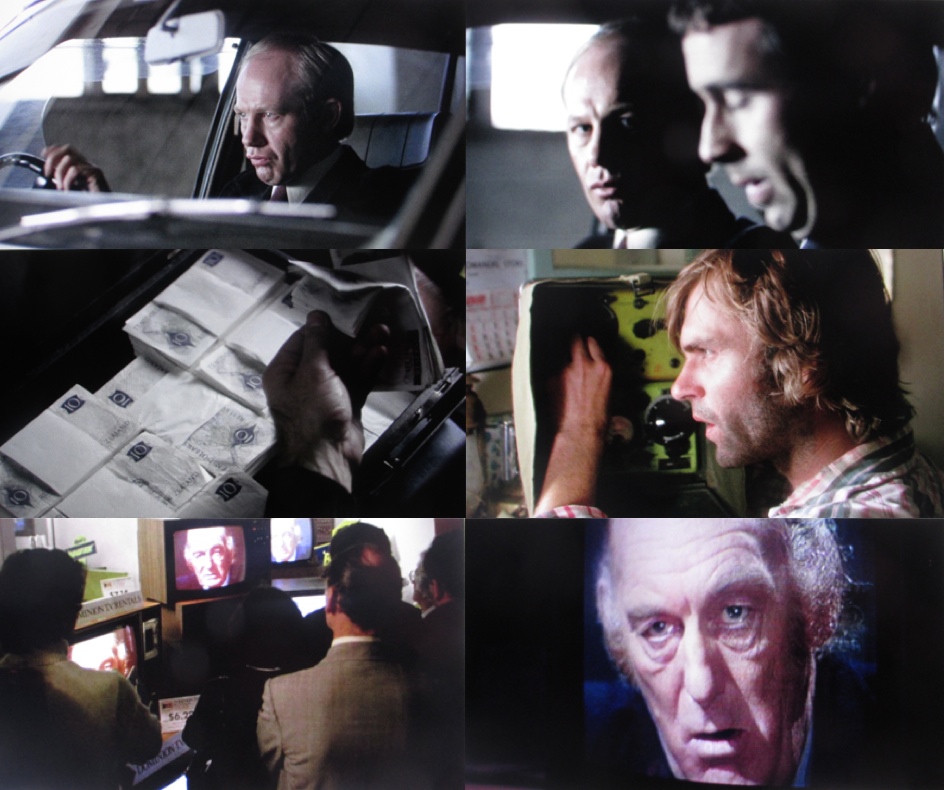
The Police – in effect – also operationalized riffs off the premise depicted in the Hollywood movie, Minority Report, by asserting an unlawful right to raid, arrest and prosecute human beings on the basis of crimes not yet committed but supposedly predicted on the basis of profiling, selection of surveillance data and records of past behaviours: pre-crime.
To this nefarious end, the Police deployed propaganda through the news media, while the accused were locked up without bail – some for a month, including the prime target for character assassination – Tame Iti. The news media, which for the most part, was derelict in displaying much skepticism, became a transmission vector for an emotional contagion of fear.
The Crown and Police were sensitive about controlling the propaganda. Evidently, a lawyer for one of accused leaked lengthy Police file to the news media.
The Crown’s Solicitor General’s Office warned TV3‘s Campbell Live that if they broadcast their program revealing parts of a leaked copy of the 156-page affidavit authored by Detective Aaron Pascoe – they would be prosecuted.
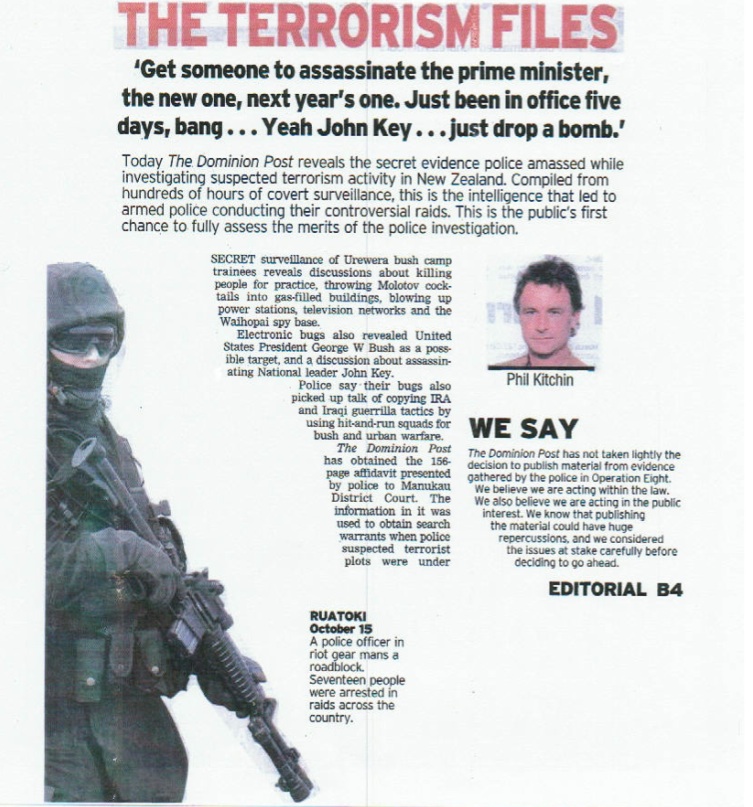
On 14 November 2007, the Dominion Post ran a lead story headlined The Terrorism Files, which the Solicitor-General viewed as a serious breach of the court suppression orders, arguing that the publication had been “deliberately inflammatory”.[10] The High Court found that Fairfax and the Dominion Post had breached the suppression orders by publishing parts of Detective Pascoe’s 156-page affidavit, but the Police declined to press charges against the press, in particular Dominion Post Pākehā editor, Tim Pankhurst. Fascinatingly, Fairfax’s proximity to the Police investigation goes along way to explaining why it brazenly defied the Crown’s Solicitor General’s warning. A former Detective Dean Winter who left the force in 2002, gained employment as head of security at Fairfax‘s online auction property, TradeMe. While at this post, Detective Pascoe’s SIG unit made requests for trading information as part of Operation Eight, as reporter David Fisher partially disclosed in an article titled, “Raid Me”, about thousands of Trade Me documents that one of the defendants, Jamie Lockett, received while in prison.
In one edition, The Dominion Post led with a headline, “IRA style war plans”, and led the article stating:
“TAME ITI was preparing to declare an IRA-style war on New Zealand in a bid to establish his long standing dream of an independent Tuhoe nation, according to police documents.”
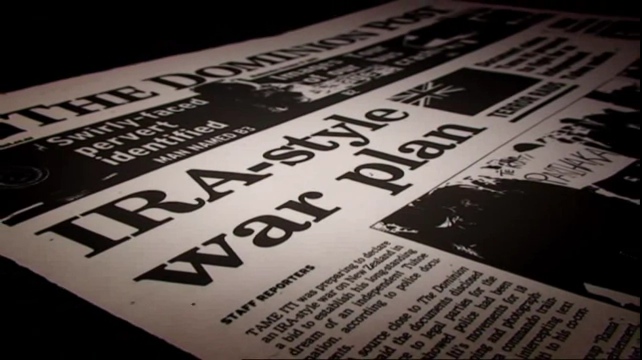
Otago University media studies lecturer Dr Vijay Devas was critical of the news media’s lack of skepticism in their coverage. Tame Iti was framed as the face of terrorism against the backdrop of the broader ‘Global War on Terrorism’. Dr Devas added:
“The media practice of selection, framing, both image and narrative, sought to purposefully link the claim for sovereignty with terrorism.”[11]
The uncritical dissemination by the news media of propaganda from Deep State actors can be detected in Operation 8: Deep in the Forest. For example, in a live cross on 3News Hadyn Jones earnestly stated that a “security source” wanted to make it clear that one of the camps was using napalm. Indeed, OneNews obliged by playing archive footage of a bush-fire in place of non-existent evidence of napalm fires. 3News reporter Hadyn Jones added that his “security source” emphasized, “we are not dealing with harmless fringe elements”. The in-joke of this statement is its double meaning. One meaning is that the Deep State was saying they consider political dissenters as fringe groups that the Deep State will not negotiate with or recognize as legitimate. The overt meaning is to make the idea of a fake terrorist group seem larger and more threatening than the reality.
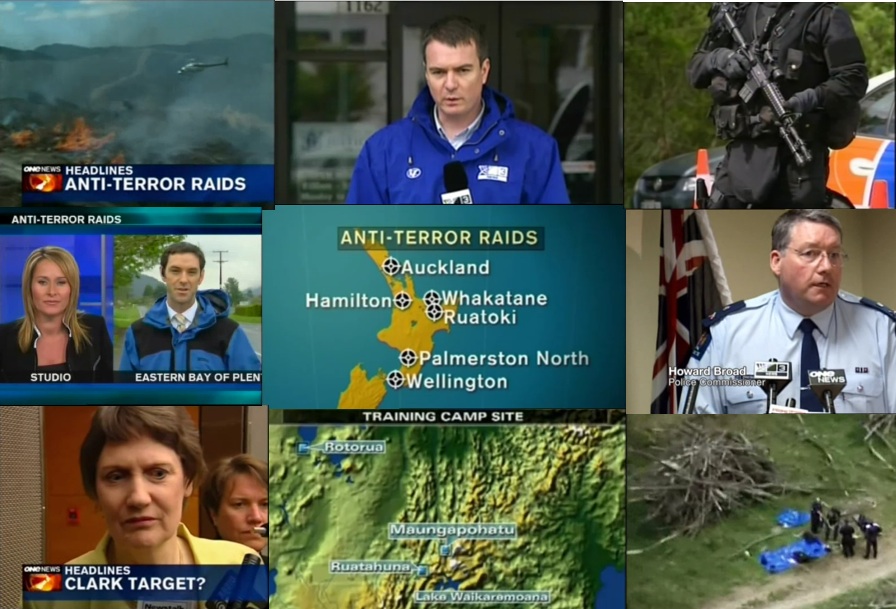
In the contempt of court case against Fairfax and the Dominion Post, Solicitor-General Collins pointed out that no planning for terrorism had occurred. It is fascinating to note that in this media court case, one of the judge’s acknowledged that some of the most sensational quotes published without context by the newspaper – such as that the accused spoke of catapulting a bus onto then-US president George Bush’s head – was simply “hot air”.[12]
Despite the obvious breaches to human rights inherent to the Operation Eight raids, Prime Minister Helen Clark and Police Minister Annette King both avoided conducting an inquiry into the over-the-top operation to examine what lay beneath.
The Prime Minister at the time, Helen Clark, framed the raids for her own political ends to bolster her credibility in the aftermath of another ‘security issue’. In a speech at a Labour party conference, Clark said, “The mere thought of paramilitary training in the Ureweras by disaffected people of many ethnicities is distressing and abhorrent to our people” – as she can be seen in Operation 8. Clark’s predominantly Pākehā conservative liberal audience applauded her over-simplifications and brazen deflection from the structural dispossession of land endured by Tūhoe and other Maori iwi and hapu. This propaganda line from a prime minister and the political head of New Zealand intelligence services was also brazenly manipulative, given that under her watch former Algerian politician and political asylum seeker Ahmed Zaoui had been wrongly jailed.
For her dirty bit-part, King deployed a diversionary argument in the parliamentary debating chamber, when replying to a question about the trauma suffered by those targeted by the raids. King downplayed the trauma, by deflecting to violence people frequently consume from television, which is not the same thing as having your family held at gunpoint for hours by hyped-up Police accusing you of being a terrorist during a ‘Termination Phase’ of a conspiratorial operation to save the state from having its own unlawful claims to sovereignty diminished. In other words, King as the Minister of Police was mocking the victims because the in-joke was that the Police B-Grade psy-op was making a Minority Report scenario ‘go live’.
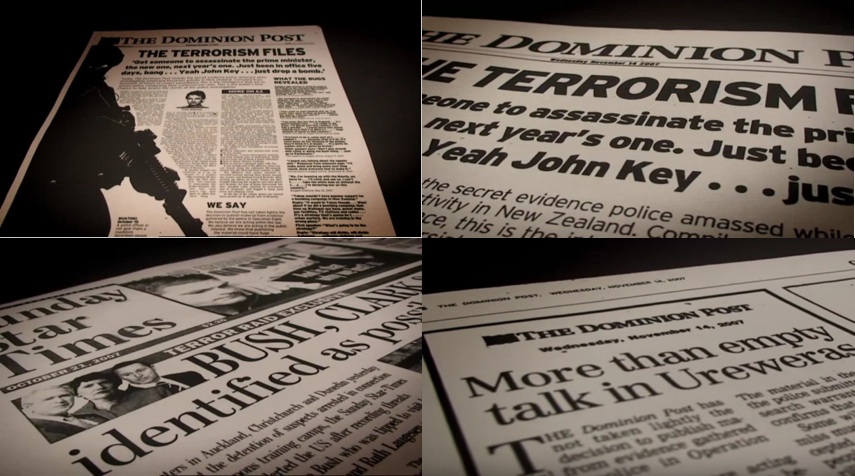
An early set-back for the élite Deep State criminal group examined here, occurred on 8 November 2007, when the Solicitor-General David Collins declined permission to allow the Crown prosecutions to proceed under the Terrorism Suppression Act due to the lack of evidence, and advised the media to report with caution. Collins added, “The police have successfully brought to an end what were very disturbing activities”. As I shall show, Collins’ opinion of “disturbing activities” were based on the deceptive frame-up job, as presented in Pascoe’s affidavit, and that his opinion was based – at best – on a disturbing gullibility.
The Neo-Colonial Deep State’s panic following Solicitor-General’s block to exploit the Terrorism Suppression Act is detectable in their subsequent moves, because it immediately made the raids look over the top to those segments of New Zealand society who are susceptible to propaganda.
After the bad publicity that the Police, Crown Law Office, and Clark’s Government received, the Deep State’s Easter Bunnies moved onward making more arrests to support their B-Grade psy-op. One such arrest was generously laden with Easter Eggs, in the form of the number Thirteen and its clones making cameo appearances. So generously laden with Easter Eggs, in fact, that the Easter Bunnies left rabbit droppings that led from the court to the Police Station, their homes and all the way to the Strategic Intelligence Unit at Police National Headquarters, in Wellington. On February 19 2008, Raunatiri Hunt was arrested at Maketu in the Bay of Plenty – among two others – for unlawfully possessing firearms. Fascinatingly, the Deep State Bunnies left their Easter Eggs in the data to signal to insiders that the case against was part of the broader psy-war to save the realm from a catastrophic succession of the terrorist-harboring Tūhoe nation.[13]
Hunt’s lawyers, Nicholas Dutch, had been lumped with 13,000 pages of ‘evidence’ from the Constabulary, which included 13 witnesses against Hunt, who all happened to be Police, who claimed Hunt was identified from surveillance footage of the alleged terrorism training camps in the Urewera. A big omission by Deep State Detective Pascoe & Co was that in their overzealous hunt for evidence of terror plot, the Police forgot to mention that the video surveillance occurred on private property, which was an illegal spying activity. The case was adjourned on the 26th of February.
Thus, the ‘Dutch lawyer’ was flooded with documents, and when the hearing re-adjourned, he appealed on behalf of his client to have Hunt’s case heard in the low-lying Tauranga District Court, closer to home rather than in the court in Auckland District on elevated ground. This was a pity, because having 13 Easter Bunny Police called as witnesses against Hunt in a depositions hearing in Tauranga District Court would have yielded more Deep State Easter Bunny data, including planted Easter Eggs and rabbit droppings.
The Operation Eight ‘Termination Phase’ was carried out in the absence of full profiling of the principle actors, before a full intelligence analysis was conducted to determine what the suspects were actually planning, and excluded Māori police such as Superintendent Wallace Haumaha from the investigation, who would have provided a more nuanced picture, skepticism and sanity. The investigation was co-ordinated by the Special Investigations Group (SIG) within Auckland Metro Crime and Operations Support (AMCOS). Brazenly, the ‘Termination Phase’ included 20-page omnibus search and seizure ‘fishing expedition’ warrants for finding the evidence they needed to justify the raids!
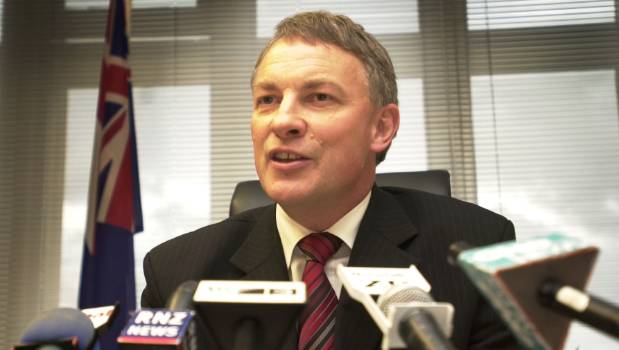
Operation Eight operated under the direction of the Police Strategic Intelligence Unit (SIU), which was approved by Cabinet in January 2002 on the justification from officials that it was needed to “focus on terrorism and transnational activity such as people smuggling, identity fraud and money laundering.” In 2004, then-Defence Minister Phil Goff announced funding for a police Special Investigation Groups (or SIG units), that were to improve New Zealand’s counter-terrorism capacity and would be “deployed for specific national security duties” by the Strategic Intelligence Unit at Police National Headquarters. Three SIG units were set up, one apiece in the three biggest cities, Auckland, Wellington and Christchurch. The New Zealand Police, who at the time of the Operation Eight raids were charged with developing a National Security Strategy – were positioned in a central role as intelligence gatherers on internal security threats – whether real or perceived. The NZ Police led the Joint Strategic Intelligence Group – which was tasked with controlling the flow of information during a ‘terrorist incident’ across multiple Police agencies, and therefore was, in effect, the Department of Pre-Crime.
Morse made the Easter Bunnies’ funny bones go numb
Meanwhile, a darkly satirical sense of humour was encoded in the Operation Eight dawn raids.
One suspect who was arrested on October 15 2007 was Valerie Morse, a Wellington-based anti-war/pro peace activist, who published her book, Against Freedom: The War on Terrorism in Everyday New Zealand Life, in 2007 prior to the raids. I contend Morse was black-listed for being a Thoughtcriminal – in the Orwellian sense. The ‘war on terrorism’ – Morse argued in Against Freedom – is the Deep State’s code for advancing the construction of a global corporate superstructure under the guise of security, trade, development, aid and democracy. Morse had also dared to criticize the Clark government for getting New Zealand embroiled in the ‘war on terrorism’, bringing it to the Pacific and enlarging the state’s capacity to undermine dissent in New Zealand.
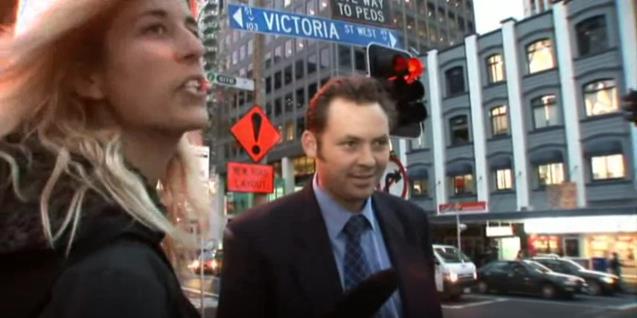
I think Morse made the Deep State Easter Bunnies’ funny bones go numb.
After-all, Morse did make numerous filings to the Ministry of Information Retrieval, also known as the ‘security-intelligence community’, who declined her requests, as she notes in her book, Against Freedom. In February and March of 2007, Morse was observed at anti-war protests in Wellington, that were also attended by Police informant Gilchrist, and Morse’s Thoughtcrimes were added to the Operation Eight log.
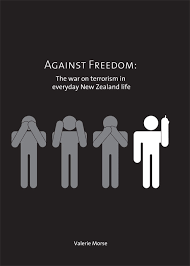
Morse cited numerous reasons underpinning the Constabulary raids of October 2007. These were: (1) create an event that justified the imminent passage of the Terrorism Suppression Act Amendment; (2) advance the game of the war on terrorism and justify the surveillance technologies, personnel and budgets; (3) undermine Tūhoe sovereignty aspirations through character assassination; and (4) attack the legitimacy of dissenting groups. Thus, Morse decoded the logic underpinning the raids, saying they telegraphed a continuum of state-making whereby the incursions into communities, households and workplaces “expanded the boundaries of sovereignty and reinforced white supremacist hegemonic power” of the ‘patriarchal state’. When the Crown Law Office dropped charges against 13 of the accused on September 6 2011, a news article “Urewera raid case a ‘house of cards’, reported Morse had read 30,000 documents presented by the Constabulary. Morse found the Police were in possession of “a very distorted picture of the aspirations of Maori for sovereignty”, and that the concept and customary law practice of tino rangatiratanga, or indigenous self-determination, was presented “as if that was a criminal idea”.[14]
Like the others who were arrested and charged, the manufactured ‘global war on terrorism’ became an everyday life fact for years for Morse,[15] until finally in late February 2013 the prime target for character assassination – Wairere Tame Iti – who most symbolized Tūhoe, was released from prison after nine months.
In other words, the Deep State Easter Bunnies ‘telegraphed by Morse code’ that the national security could inflict a manufactured global war on terror psy-war in the South Pacific Realm of New Zealand and make it an everyday life fact long after the Clark Ministry.
In her review of the Operation 8 documentary published in the State Crime Journal, Stéphanie Bürgenmeier noted that Massey University counter-insurgency expert, Dr Jeff Sluka, had told the Operation 8 filmmakers that since the rise of the ‘New Right’, the New Zealand government had pursued a course to suppress dissent by criminalizing it. The state’s goal was, “to redefine essentially political opposition and resistance as terrorism”, Sluka said.
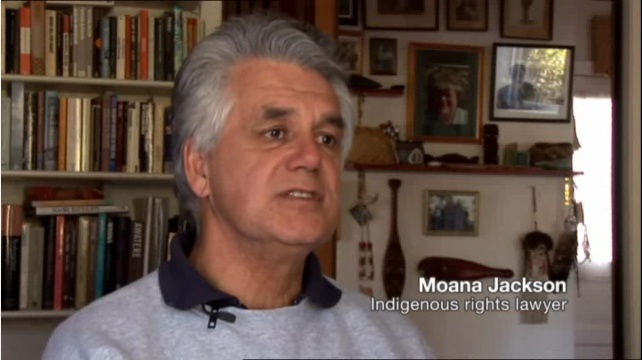
Bürgenmeier noted that Moana Jackson said in the film:
Tūhoe were at the time [of the raids] engaged in negotiations over the return of raupatu [confiscated) land. I think a clear part of the strategy behind the raids was to send a message that there were limits to what the Crown was prepared to do.[16]
In her book Against Freedom: The War on Terrorism in Everyday New Zealand Life, published in 2007 prior to the Operation Eight raids, Valerie Morse argued the ‘war on terrorism’ is the Deep State’s code for advancing the construction of a global corporate superstructure under the guise of security, trade, development, aid and democracy. Morse had criticized the Clark government in her 2007 book Against Freedom, for getting embroiled in the ‘war on terrorism’, bringing it to the Pacific and enlarging the state’s capacity to undermine dissent in New Zealand. Like the others who were arrested and charged, the manufactured ‘global war on terrorism’ became an everyday life fact for years for Morse, until finally in late February 2013 the prime target for character assassination – Wairere Tame Iti – who most symbolized Tūhoe, was released from prison after a nine-month gestation period.
Manufacturing Native Accent
Following the Parole Board’s announcement on 26th of February 2013 Iti was ‘set free’ to range around this dirty little country and Tūhoe territory. Tame Iti’s release was needed for the Crown to exploit the catharsis, and his presence at the looming ‘settlement’ was required to help the Crown pass the political hygiene test.[17]
To this devious end, less than a month later on 23 March 2013, Tūhoe hosted a Cathartic Settlement Ceremony with the Crown that was primarily represented by Waitangi Treaty Negotiations Minister, Chris Finlayson.
This timing was exquisite, because it occurred once negotiations with Ngāi Tūhoe negotiators, Tāmati Kruger and Kirsty Luke, were were far enough along that the ground around the Tame Iti faction had been safely sidelined. On September 11 2012, or almost four months afer Tame Iti was sentenced, the Crown announced it had reached an agreement with Tūhoe for a $170 million settlement of historic grievances.[18]
In 2010, Prime Minister John Key had taken the return of the Ureweras to Tūhoe off the negotiating table. As we shall see, the Urewera mountains, lakes and rivers were not returned to Tūhoe.
In this way, the Neo-Colonial Crown had successfully wielded its subterfuge to maintain sole sovereign power status.
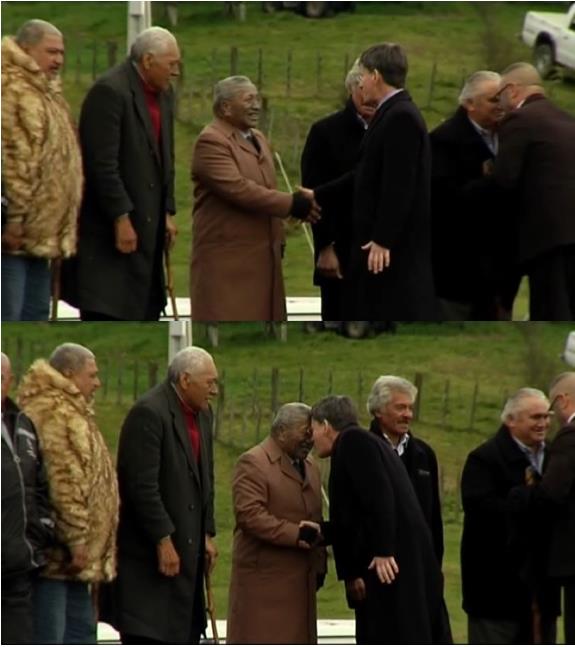
The Crown’s sole soveriegn power status had been accomplished with a stealthy process to gain native assimilation, paper sovereignty and substantive conquest of soil – in keeping with a 15th Century Doctrine of Discovery.
To be super-clear, unbeknown to Māori at the time of signing the Māori version of the Treaty of Waitangi, the British government and its colonial agents had been systematically deploying a secret international law agreement since Freemason Bro. Captain Cook’s first voyage.[19] Known as the Doctrine of Discovery, this secret piece of international law was reached between European nations at a time when they were forming empires since the 15th Century, and was designed to mitigate the chances of competing nations making expensive war with each other. It was thought it would be easier to gain territory off indigenous peoples’ cast as ’savages’ rather than from their more technologically even European competitors. Through the application of another international law doctrine – terra nullius – the natives’ of the ‘New World’ were considered to lack full political rights because they were not Christians busy cutting vast swathes of forests for sheep and cattle to graze and therefore they were deemed too ‘primitive’ to be considered ‘sovereign’.[20] Not surprisingly, ‘colour prejudice’ as a “conscience-salving colonial doctrine” surfaced around 500 years ago, coinciding with the emergence of the European empires.[21]
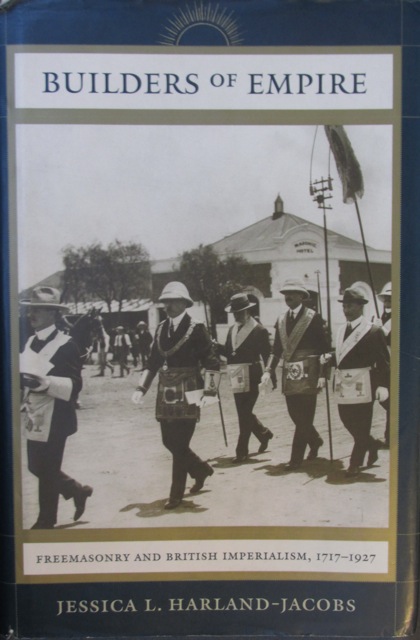
Not surprisingly – given the epic rort with which the British Crown exploited the fraudulent English language version of the Treaty of Waitangi – the Conquest stage of empire (also a Discovery Doctrine element) manifested into what I call The Masonic New Zealand Wars. As I have shown in my illustrated essay, Freemasons dominated key positions in the political, military and commercial apparatus of Colonial New Zealand and conspired in the crucial 1858 to 1868 period to destroy the Māori communal economy, with which the colonists could not compete. As Jessica Harlands-Jacobs showed in her book, Builders of Empire: Freemasonry and British Imperialism, 1717-1927, the primary secret mechanism by which the British Empire spread throughout the ‘New World’ was through the secret society of Freemasonry, and in turn, Freemasonry was spread mostly through the military regiments, including the navy. However, as a study of British Masonic Imperialism, Harlands-Jacobs’ work does not reveal the network of the secret brotherhood and, therefore, their roles in the British Empire remain obscure to the reader.
However, other accounts such as John Daniel’s, Scarlet and the Beast. Vol. 1: A History of the War between English and French Freemasonry, Webster Tarpley’s The British Empire Bid for Undisputed World Domination, 1850-1870, and Nicholas Hagger’s aforementioned, The Secret History of the West, and rare books published privately by Freemason Lodges in New Zealand – reveal a sharper lens through which to review New Zealand’s colonial history. For instance, the British Prime Minister throughout the peak period of the New Zealand Wars was Lord Bro. Palmerston (1859-1865), who appointed Freemason Bro. George Frederick Samuel Robinson, 3rd Earl de Grey, as Secretary of War on April 13 1863, meaning Freemason Governor Bro. George Grey – the Commander-in-Chief – was taking war orders from the secret network of Freemasonry that ruled the British Masonic Empire.
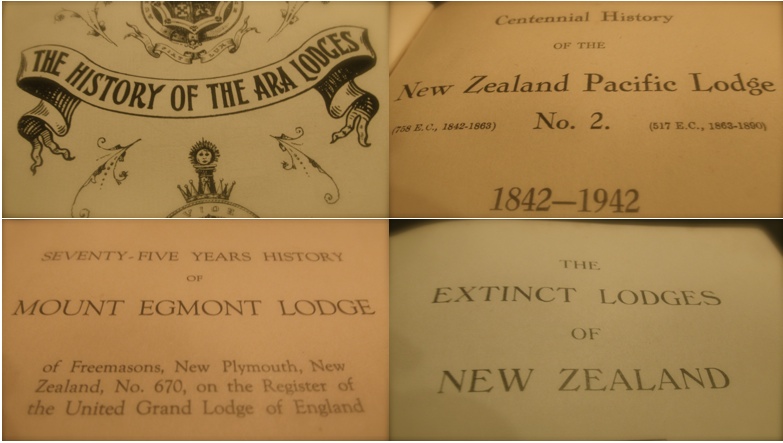
The Masonic-dominated New Zealand Colonial Oligarchy pursued an imperialist vision to construct a British Masonic Utopia that envisioned Māori as a race of savages who were to be recast as a workforce of landless labourers to help build-out the new Masonic territories before they were meant to quietly die out. This is the hidden layer of New Zealand history that Queen Elizabeth II neglected to mention when she co-signed the Tainui settlement with then-Māori Queen Dame Te Ātairangikaahu in 1995, a history that the British Monarch is well aware of. (After-all, ‘Her Majesty’ gave Harland-Jacobs access to the records of British Freemasonry in the Royal Archives). Therefore, the so-called full and final Treaty Settlements have proceeded without full disclosure, because an unsanitized account would set in motion a full restoration sovereignty necessitating the forfeiture of the Crown’s fraudulent presence in New Zealand.
Even without these unwoven facts of Masonic intrigue being widely known, the Crown was still vulnerable to a Ngāi Tūhoe secession – or, at the very least, winning the full customary land sovereignty, ownership, and title over Te Urewera. Therefore, the Crown needed to divide, distract and defeat Tūhoe – again.
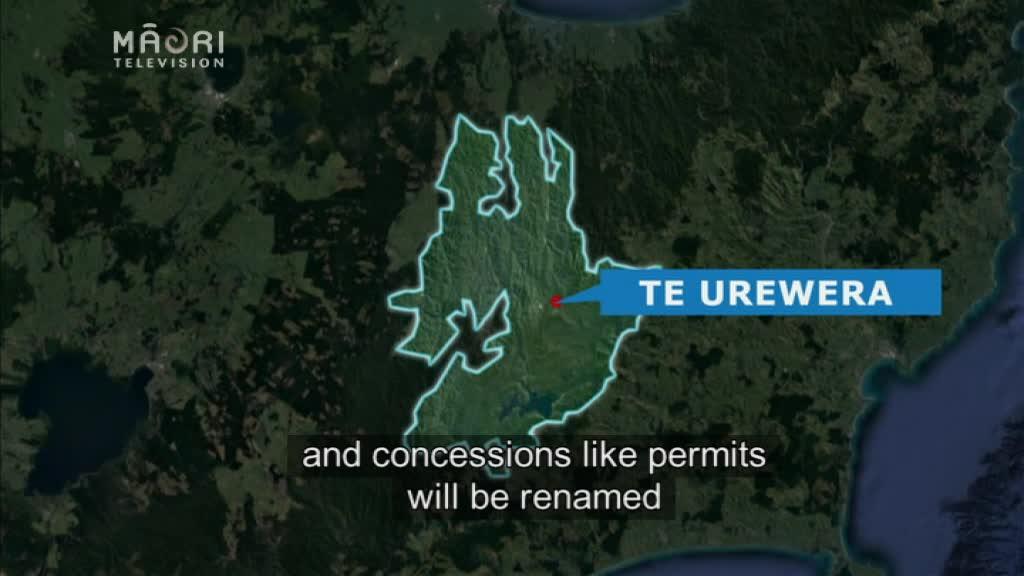
Tame Iti’s B-Grade ‘freedom-fighter’ uprising idea provided the opportunity for the Crown’s Deep State to construe his bush wananga as a “private militia in formation” – in Judge Hansen’s words. This view was arrived at, through circumstantial evidence and illegal surveillance recordings re-constructed out of context by the Police SIG unit, and without consideration for the underbelly of machinations that had already been partially exposed by Abi King Jones’ and Errol Wright’s documentary, Operation 8: Deep in the Forest. Justice Hansen’s view was so predictably inadequate – it was as if it were conceived by a B-Grade psy-op script-writer.
In other words, the Crown has brazenly granted a concession – a fee simple feudal estate title supposedly in perpetuity for ‘the natives’ of Tūhoe to have board positions. Tūhoe have essentially been conferred limited neo-feudal rights as park rangers over lands the Crown stole!
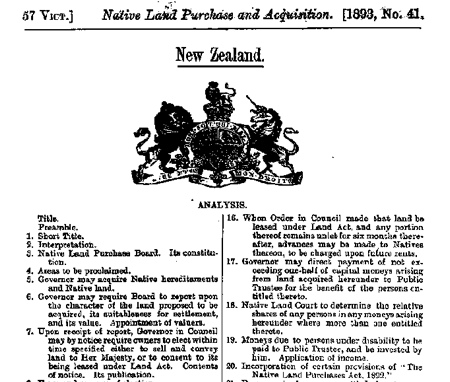
Indeed, the ownership of the Ureweras was not transferred to Tūhoe as an iwi in its pre-1840 state superior to Māori customary land title (that hardly any Māori land is classified as), and is therefore technically alienable.[22] For historical wrongs perpetrated by the Crown, Tūhoe received a mere $170 million in compensation for land lost. I believe this chain of events adds weight to my argument that the objective of the raids on Rūātoki had been achieved.
A neat trick has occurred.
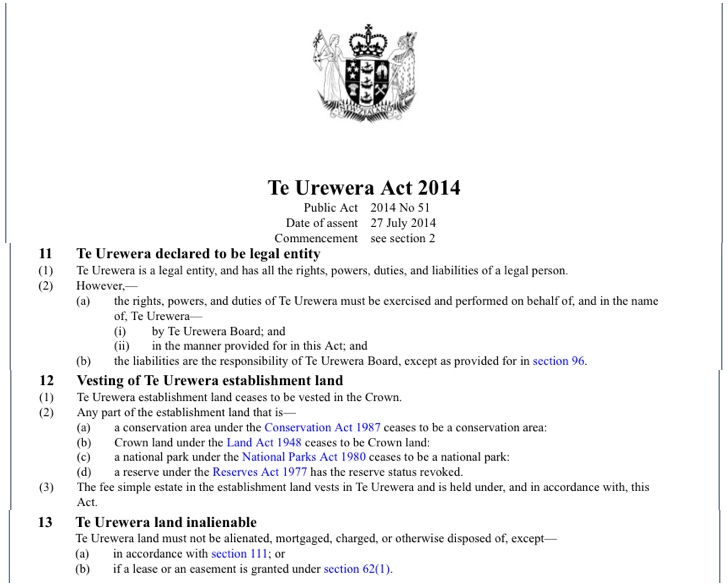
In 2014, with the passage of Te Urewera Act, the 821-square-mile Te Urewera national park ceased its legal life begun in 1958, and was granted the status of ‘personhood’ – like that of a corporation – with Royal Accent under British law. Attorney General, Chris Finlayson, claimed the issues over guardianship and ownership were resolved by working with the Māori paradigm. “In their worldview, ‘I am the river and the river is me,’” he said. “Their geographic region is part and parcel of who they are.” [23] That is to say, “no one owns Te Urewera”.[24 These rhetorical statements were semantic descriptions that pulled at the heart-strings of The New York Times’ readership and even fooled the Māori Law Review journal.
Te Urewera is now ‘co-governed’ by Tūhoe and the Crown. This sounds like a nice grown-ups compromise. Although the Act says Te Urewera is inalienable, it also states an exception if authorized by an Act of Parliament, meaning Te Urewera as a legal person is subordinate to the Crown Overlord. For instance, Te Urewera is subject to the Crown Minerals Act. As a 1992 Law Commission discussion paper, “Tenure and Estates in Land” states:
“All land ultimately belongs to the State, as personified by the Crown. The fact that only the Crown can be the absolute owner of land is a basic concept of English law and New Zealand law. The only exception is land still held under Māori customary title … and [e]ven in that case the Crown has paramount (or “radical”) title. It is a fundamental principle of [English] law that all lands are holden of some superior lord”.[25]
Te Urewera ‘establishment land’ title is merely fee simple, which confers estate rights to land-holders to use and profit from the land provided the tenure obligations to the Crown are met. Te Urewera is subject to tax, meaning Te Urewera as a legal entity has been incorporated into the Queen in Right of New Zealand’s Tax Farm. The Board and Te Urewera are deemed to be the “same person”, meaning that Te Urewera and the Board have been granted a “feud” or “fee”, essentially as tenants to pay tax revenues to the Crown and supply services on behalf of the Crown, meaning the Te Urewera Act observes the doctrine of feudal tenure. Whereas in feudal Britain, the aristocracy was expected to supply knights to defend the realm and pay tribute on land ultimately owned by the sovereign, today in New Zealand, Tūhoe customary practices of Te Urewera are now subject to statute law overseen by a small Neo-Colonial board that has equal Crown representation, and takes advice from the Department of Conservation. In short, the Te Urewera Board have been cast as high-ranking park rangers – obligated to pay tributes.
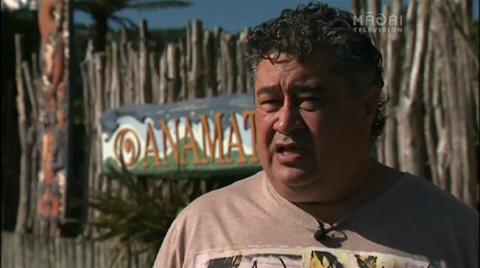
To be super-clear, I am not saying that Tāmati Kruger and Kirsty Luke were stooges for the Crown. What I am saying is, Kruger and Luke were negotiating from a weakened position, as an intended in-built consequence of the so-called anti-terror raids. Even though Tame Iti and Tāmati Kruger resolved after the raids not to let the court cases that were running parallel to the Ngāi Tūhoe and Crown settlement negotiations affect the iwi’s capacity to negotiate – it did, hugely.
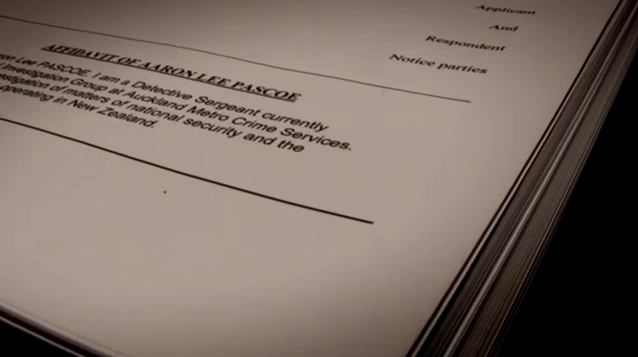
The so-called Independent Police Conduct Authority inquiry into Operation Eight (Urewera Raids) failed to consider the ulterior motives of the ‘intelligence community’.[26] In particular, the Special Investigations Groups (SIG), the Auckland Metro Crime and Operations Support (AMCOS), the Strategic Intelligence Unit at Police National Headquarters, the Joint Strategic Intelligence Group, Police Armed Offenders Squad (AOS) and the Northern Special Tactics Group (STG), and possibly the SIS and the Government Communications Security Bureau (GCSB).
The Crown’s propaganda was only modified on the aspect that the raids were over-the-top, the result of widespread condemnation. The Independent Police Conduct Authority did not admission that the overbearing raid was done deliberately to undermine Ngāi Tūhoe’s mana to get sovereign ownership, control and possession of customary territories back.
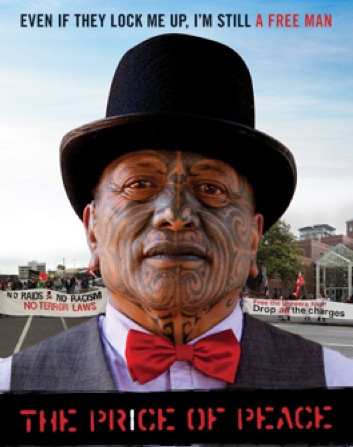
Subsequently, in the ‘Urewera Four’ Trial, Justice Hansen’s view was that a “private militia was in formation”. Justice Hansen quoted alleged surveillance intercepts and accounts, stating that Mr Iti described the group as, “a revolutionary military wing o Aotearoa … to smash the system”.[27] In journalist Kim Webby’s documentary, The Price of Peace, Tame Iti said that the Crown prosecutions’ assertions of intentions for murder, kidnapping and arson were “serious allegations”. Iti also said:
“We had no intention of hurting people. This is something they invented. This is a lie.”
I believe Iti did fantasize about an armed rebellion – like the others in mid-banter, bonding, venting, or when boozed. But fantasizing is a far leap from the imaginary Make-Believe World to strategizing, mobilizing and operationalizing in the Make-Real World where Crown jurisdiction collides with its pirate past and its psy-spook present.
Iti was not a mean-spirited person to actually plan, mobilize and implement an uprising, if the violent form was what he meant. He may have meant non-violent, direction action-type uprising when he spoke at Parihaka. Iti neglected to define his terms. Kim Webby reflected after making her documentary, The Price of Peace, the journalist said she felt she did not get a totally straight answer from the Tūhoe activist and artist.[28] I believe Iti was just frustrated – blowing hot air – in the same way that world leaders do.
Except, that Iti did not have the resources of the likes of George Bush II to order even a low-grade war of terror – of the likes of Operation Gladio in Western Europe for 40 years that were escalated under U.S. General Lyman Lemnitzer’s pstchopathic watch as Supreme Commander of NATO. Historian Daniele Ganser found the NATO countries had perpetrated a “Strategy of Tension” designed to frighten the mass populaces of Europe and thereby shift the political gravity to the ‘right’ by blaming ‘left’ wing communist groups for the carnage of Operation Gladio that involved ‘false flag’ bombings of trains, planes, automobiles, buses, and buildings.[29]
Key insiders that involved the CIA, MI6 and the Coordination and Planning Committee (CPC) of NATO’s Supreme Headquarters Allied Powers Europe (SHAPE) manipulated people with the subtle propaganda that a ‘free world’ equated with capitalism.[30] It is these same NATO powers that New Zealand’s Crown Police, Defence, Intelligence and Security apparatus are aligned with. New Zealand’s Neo-Colonial national security state play a game of pretend that they don’t know that NATO countries together funded, trained and armed terror networks in Western Europe, Central and South America, and South East Asia, under the auspices of Operation Gladio, Operation Condor, and Operation Phoenix, respectively. N.Z.’s Deep State Easter Bunnies also play a game of pretend by going along with the official narrative of 9/11. In doing so, the Deep State Easter Bunnies have cast themselves as super dumb.
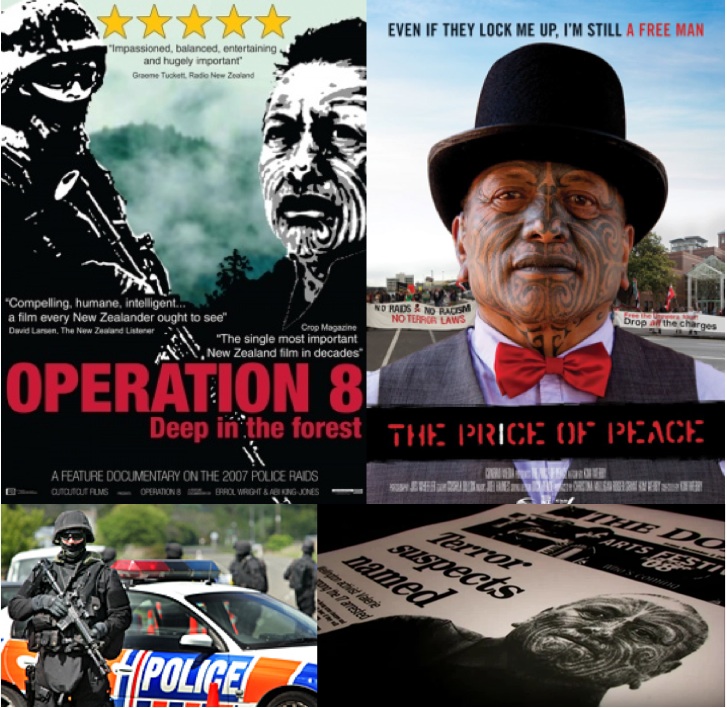
Because any nine year old with a laptop and an internet connection can work out in five minutes flat that for three steel reinforced concrete towers to ‘collapse’ due to office fires in one day –the World Trade Center skyscrapers must have been prepared with military-industrial grade controlled demolition explosives and directed energy weapons.[31] Indeed, since school children learn that three related events set a pattern that can predict results as denoted by the simple mathematical pattern like 3, 6, 9 … they are able to see that 12 is the next number in the sequence. Thus, when nine year olds find that steel reinforced concrete towers have never totally ‘collapsed’ due to office fires, they can see that the feat of three such collapsing in one very bad business day in Gotham, should have happened with other infernos before or since.[32] But there hasn’t as the 2008 documentary 9/11: Blueprint for Truth, sponsored by a U.S. network of Architects and Engineers for 9/11 Truth compellingly shows.[33]
It is, therefore, deeply ironic that the Police Special Investigation Group (SIG) knew Iti did not have the talents, means or ill-will to carry out a terrorism plot and instead opted for maximum character assassination via an orchestrated B-Grade propaganda campaign, that required an over-the-top raid on Rūātoki – for effect.
In other words, Police Special Investigation Group (SIG) at Auckland Metro Crime Services could not wait for bomb or assassination plots that would never eventuate.
The only dangerous device ticking was the Crown’s clock and the only assassination plot was a mass character type aimed at ‘left-wing’ causes, Tūhoe – who wanted the Ureweras back – with Tame Iti as the prime target – and Māori in general via a not-too-subtle conflation of sovereignty aspirations with terrorism.
Here, we get to the nub of the issue regarding the Crown’s bad faith approach to neogiating with the Tūhoe tribe – rather than with hapū. Tribes are a construct of larger groupings comprised of hapū that can be easily played off against one another in the grand Roman tradition of divide and conquer, while indigenous élites susceptible to egoism can be targeted for manipulation. Thus, by discrediting radical factions through subversive means, a handful of representatives can be elevated, however reluctantly and thornily – as I am showing here.
The rub for Crown officials was that they could not deny Te Urewera National Park and the flat-lowlands stretching to the coast at Whakatane had been acquired by swindle, struggle and stealth. These unwoven facts – together with the Tūhoe tribe’s fairly well-known aspirations for secession – posed such a threat to the Crown that the situation needed careful, coordinated crisis management. If Tūhoe re-gained full sovereignty over Te Urewera, other lands and coastal areas, then other iwi, whānau, hapū, marae and rohe would follow suit – and not just those whose forebears never signed the 1840 Treaty. Because Māori legitimately hold the view that their forebears never signed away sovereignty with signing Te Tiriti o Waitangi in 1840 – as the Waitangi Tribunal has shown – the Crown’s whare is built on lurching foundations of unlawful sand.
Gun-barrel diplomacy as a blackmail mechanism
Brazenly, New Zealand’s Deep State Easter Bunnies authored the Operation Eight paramilitary raids to target rag-tag suspects whom had no capacity for orchestrating an uprising – whether violent or peaceful. The Police intelligence apparatus framed them in a non-existent terror plot with detectable traces of the Sleeping Dogs screenplay as part of a broader agenda to prevent Conversation Estate and Crown Minerals Estate lands reverting to the Native Estate o Ngāi Tūhoe.
Vietnam veteran, intelligence analysis expert and Parnell Businessman Ross Nepia Himona points out that some activists refused to take part in the ‘war games’, and that in his view, these were fantasies. Himona viewed all the video evidence and concluded that one of the participants, Rau Hunt, was simply demonstrating the tactics of vehicle, convoy and personal protection used by civilian contractors in ambush situations in locations such as Iraq and Afghanistan. Himona said the police construed the video recordings as evidence of hostage-taking exercises.
Himona drew on his expertize in intelligence analysis to make a study of the Detective Pascoe’s 156-page affadavit, the evidence, and the court transcripts. Himona, who presented his findings in a series of articles on his blog, Te Putatara, stated the Police also ‘failed’ in the final stage of intelligence analysis to find out what the suspects were really planning. Himona also said the Police neglected to do thorough profiling of the principle actors that would have helped them understand ‘the suspects’ better, and therefore make sense of the data gathered. Moreover, Pascoe’s affadavit contained numerous redacted paragraphs justified because they evidently referred to “Police Surveillance Techniques”.
The Parnell-based businessman, who premises were also raided on 15 October 2007, said the illegal video recordings that appear to show hostage-taking scenarios were pivotal to the final ‘Urewera Four Trial’. He said that what the Police perceived or portrayed as the most damning parts of conversations was ‘trash talk’, meaning that if they had bothered to understand the principle characters, their cultural backgrounds and pasts, and get expert opinions, they would have realized they had happened upon a group running on the smell of an oily, led by physically unfit men who shot off at the mouth while bonding. He said the conversations deserved to be the most intensely analyzed, but were were simply accepted at face value. Himona wrote:
“This korero was about going to war, about a revolution, about doing robberies to raise funds, about Tuhoe freedom fighters, about studying IRA and Al Qaeda manuals, creating chaos, bombing strategic facilities, urban warfare, obtaining weapons and ammunition, and assassinating the next prime minister (John Key).”
Himona said his expert eye could see that Iraq War veteran Rau Hunt was demonstrating anti-ambush convoy protection techniques as a part of the mid-October 2007 wananga, adding that it did not make sense for him to put his civilian war-zone contracting business in jeopardy by knowingly participating in a terrorist group.
Likewise, Himona said his own accused employee, Rangi Kemara, an IT specialist, had taken to collecting guns, and that his main sin was co-developing an encrypted Māori activism chat forum, AoCafe, that Police seemed to think would contain the motherload of conspiratorial communications. This association made Himona’s business the target of a raid on October 15 2007. His at times hilarious ‘only in New Zealand’ account reveals the Police raid was a fishing expedition for evidence. This was also the only raid where Māori Crown Police were put in charge. When Himona realized their intention was to seize all computing equipment, he stopped their incursion with a swift High Court injunction to save his business upon which numerous people relied for employment.
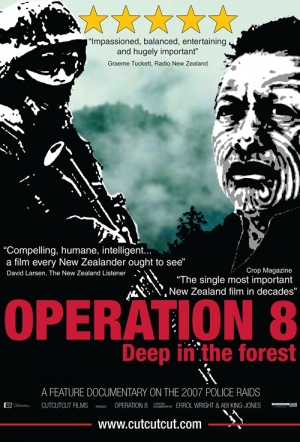
Operation Eight was formally launched in May 2006, and appeared to be focussed on a handful of individuals, mostly on serial police antagonist, Jamie Lockett, and millionaire used car trader, John Murphy, among a few others; which Himona termed a ‘right wing revolutionary plot’ narrative. Tellingly, on the Brotherhood’s favourite day of any month, the 13th of September 2006, the profiles of all of Tame Iti’s known associates were logged as evidence into the Operation Eight case file. Two days later, on 15 September 2006, the nationwide search for a terrorist network, in effect, began with the first of numerous call data warrants to obtain telephone metadata and text messages. This was exactly 13 months before the activation of the ‘Termination Phase’ of Operation Eight. From May to October 2007 the warrants were issued under the Crimes Act 1961 and the Suppression of Terrorism Act 2002. This indicates that the Police had formed their terrorism narrative by early May 2007.
What started as an alleged criminal network comprising of Pākehā with Tame Iti on the periphery, and morphed into an alleged terrorist group with Tame Iti at its core.
Evidently, a parallel construction of evidence had occurred because Himona thinks the Operation Eight database shows the investigation targeted Jamie Lockett, who was logged as the first person of interest in the Operation Eight database on 24th September 2005. Lockett cast himself as an activist, but wasn’t in Himona’s opinion. Lockett’s track record of provoking Police at protests to arrest him, seems to lay bare that he was really a man with a deep-seated loathing for Crown Police. A violent encounter with Detective Sergeant Phil Le Compte, who evidently came off second-best, appears to have set Lockett on a trajectory to get framed for something bigger, because Le Compte worked at AMCOS, co-located with SIG, the special intelligence unit that ran Operation Eight.
The Northern SIG unit, headed by Detective Sergeant Aaron Pascoe, were interested in finding out what Lockett was doing with Murphy. To this end, the SIG unit turned a friend of theirs, Keith Madden, into an informant. Madden approached Ross Himona’s IT specialist, Rangi Kemara, through Jamie Lockett and offered Kemara an automatic shotgun in January 2007, which are illegal. This offer set off alarm bells, and Lockett and Kemara became suspicious. Shortly after, Lockett came into possession of a copy of a letter that Madden had sent to his Crown Police handler. Locket showed Kemara and then took it to Tame Iti on 3 June 2007, which was the same day that Iti received text messages telling him that the activities in the Urewera were mentioned at Crown Police HQ in Wellington. The letter discusses Madden’s understanding of what his informant role was:
“to link probable multiple individual agendas with the commonality of a mutually shared proven criminal theme of agenda. A hard ask albeit even with the affront to operate a terrorist training facility in our summer playground backyard, the Bay of Plenty.”
In Himona’s thoughtful and scathing assessment, this intercepted letter showed that Detective Sergeant Aaron Pascoe,
“didn’t have the evidence he needed to prove his terrorism narrative. He never did get it. The Solicitor General’s refusal to allow terrorism charges to proceed proved that.”[34]
In my assessment, Commissioner Howard Broad knew that the Crown Police SIG unit’s standard of evidence was deficient. Broad’s face said it all when he said “No”, in answer to a reporter who asked him that great question – “was there any suggestion from the group that they were planning to take any action?” – at an early press conference!
I think the Police Commissioner was coerced into authorizing the ‘Termination Phase’ of Operation Eight, and seeking sign-off from the Cabinet. This coercion may have come from within the SIG unit, higher up in the Police in Auckland, and Wellington, from the SIS, or perhaps other elements of the Deep State such as the Political Elite or New Zealand’s Ruling Families. In any case, the ‘Termination Phase’ appears to have been ‘brought forward’ to fulfill the multiple agendas outlined.
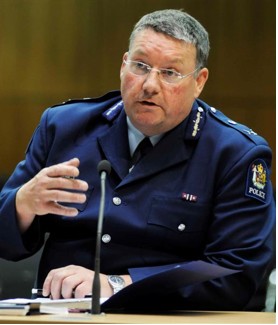
The frame-up could well have been inspired by Sleeping Dogs, or any other political thriller movie, since its flimsy ACT I narrative elements show parallel construction, wherein multiple institutions, players and technologies are engaged to advance the ‘case’ and fix ‘the evidence’ of an enemy image to the hapless cast of scapegoats. But like all criminal plots, matters go awry for Deep State Bunnies, and when they do go wrong, the crises escalate prior behaviours and become pretty transparent on the surface as messy Deep State rabbit droppings. When Sam Neill’s character Smith in Sleeping Dogs is arrested by the Special Police, he asks Police Commissioner Jesperson what it is he is supposed to have done wrong. Commissioner Jesperson replies:
“Well Smith, there really are quite a few things aren’t there, when you haven’t registered? You had in your possession an illegal weapon and ammunition. You had an illegal radio transmitter. You’re an associate of two known saboteurs. On various parts of your island were explosives and a variety of weapons. Under present law, just the items in your possession – a military court could have you executed.”
Commissioner Jesperson attempts to coerce Smith into making a ‘voluntary confession’ that he is a revolutionary, providing details of who supports the resistence, where all the arms and supplies come from, and that the aim is the overthrow of established democratic values. For this confession, Commissioner Jesperson promises Smith safe passage out of the country to avert certain conviction and execution by firing squad. At this point in the film, Smith knows little about the resistance to the Police State.
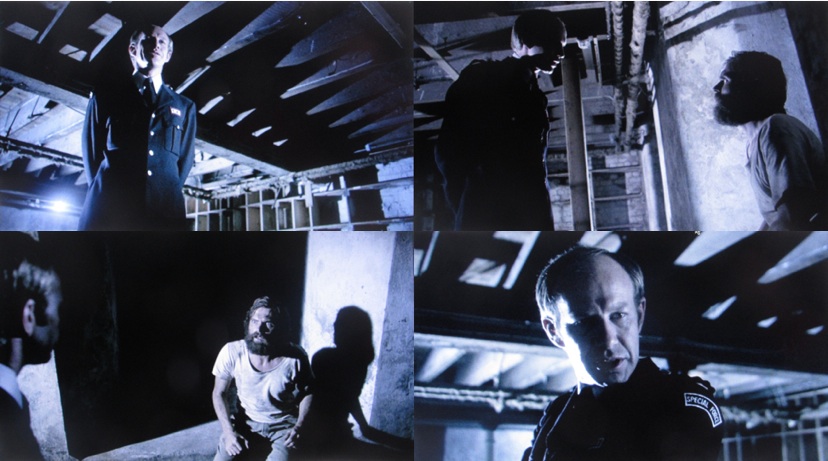
In a parallel universe to the Sleeping Dogs plot, the Auckland SIG unit’s informant Keith Madden also knew little about the Tame Iti’s wananga in the Urewera ranges. In circumstances that are simultaneously spooky-silly and tragically pathetic, Madden, who was turned against his friends, appears to have been instructed to lure Rangi Kemara into buying an illegal automatic shotgun. Kemara, a known associate of others in Detective Sargeant Aaron Pascoe’s sights, it would appear – was being ensnared as part of the ‘revolutionary group’ narrative that the Special Investigation Group perceived it needed to justify its existent in this dirty little country – where most of the dirt is claimed by the Deep State – with a quislings’ attempt at entrapment. In the documentary Operation 8: Deep in the Forest, it is left to Valerie Morse to explain that under the Crimes Act, you don’t have to own a gun, or have touched a gun or even seen a gun, to be accused of being in possession of a gun. It is not Pascoe, or Burns, Broad or Gilroy explaining on the multi-season long Operation Eight News Special how a weapons possession charge works. It turns out, you only have to be linked to people who own a gun, or be located at a property where a gun is claimed to be, for the Crown Prosecution to widen the net of those caught up in a Deep State psy-op.
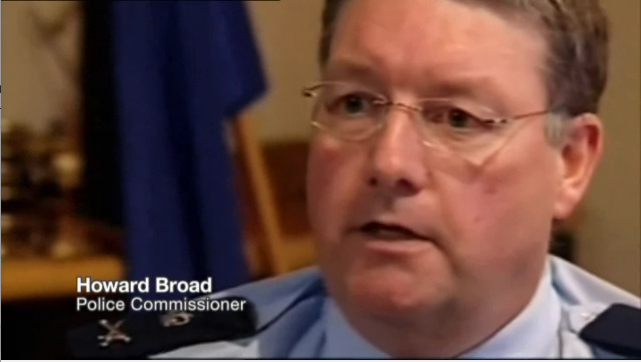
When it is recalled that Morse stated that Crown Police informant and agent provocateur Rob Gilchrist had unsuccessfully encouraged her to commit burglaries in Wellington and Auckland and to make bomb threats, a pattern of Crown Police attempts at entrapment is revealed. This pattern shows the SIG Units, that were set up under the command of Strategic Intelligence Unit headquartered at Crown Police HQ in Wellington, itself founded for the purposes of counter-terrorism, were not only contracting individuals to be informants infiltrating dissident groups. The SIG units were paying their spies to encourage their targets to breach the Crimes Act and Terrorism Suppression Act, by either luring people loosely-linked in the orbit of Tame Iti and Jamie Lockett – the make bomb threats, or purchase illegal weapons or commit burglaries. Thus, by attempted entrapment, the Police SIG Units were seeking to construct the evidence they needed to advance the terrorism narrative.
Ironically, Tame Iti’s positive assessment of the result of this Deep State episode in coordinated subversion is a weird form of Stockholm Syndrome. At his TedTalk presentation, Iti said:
“After one hundred and seventy years of struggle, of fighting for the mana o Tūhoe, we finally got respect and understanding from the Crown.” [35]
Iti played a clip in which Attorney General and Treaty Negotiations Minister, Chris Finlayson, performed the clichéd Meā Maxima Culpā Catharsis Ritual, claiming:
“The Crown unreservedly apologizes for not having honoured its obligations to Tūhoe under Ti Titiri o Waitangi, and profoundly regrets its failure to appropriately acknowledge and respect te mana o te Motuhake O Tūhoe for many generations.”
It’s a comforting narrative for the ears of conservative liberals and liberal conservatives.
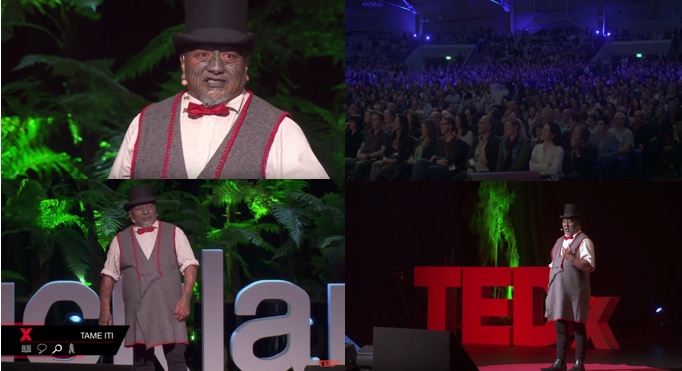
From the perspective of doing one’s job honestly and properly, Finlayson’s quisling avoidance from investigating Operation Eight was a dereliction of his duty as Attorney General, since the Solicitor General’s Office is under his authority, and therefore the Crown Prosecution is answerable to the Attorney General. From the perspective of protecting the Neo-Colonial state’s addiction to committing power crimes, Finlayson avoidance was amounted to lying by omission in furtherance of the psy-op’s crimes of deceit. Therefore, Finlayson’s ‘apology’ on behalf of the Crown during the Treaty settlement was insincere designed to produce a cathartic effect to ‘switch on’ a forgiveness response so that the Crown could get away with its power crimes and maintain its jurisdiction. But, it was not simply a dereliction of duty. The undermining of Tūhoe’s mana through the Operation Eight psy-op worked hand-in-glove with the Tūhoe-Crown negotiation process.
Pertinently, in October 2012, former Detective Dean Winter was ‘helicoptered’ into the Crown Law Office – out of which operates the Attorney General’s Office and the Solicitor General’s Office – to lead a new prosecutions unit formed after a review of prosecution services in 2011!
This move occurred while Tame Iti was behind bars painting artworks and just after Tūhoe reached its ‘Treaty settlement’ agreement with the Crown. As Maori Television reported, the settlement agreement included concessions liking changing the names of permits. This is incredibly ironic given that Tūhoe Lambert stated sarcastically in Operation 8: Deep in the Forest:
“You can’t just go up to the lake and say ‘shit, I’ll just go catch me a fish.’ No, we have to go get a license first from the ranger.”
Moreover, the ‘Treaty settlement’ was a brazen robbery because the Crown had reached an agreement for a ‘co-governed’ Tūhoe board to pay tribute for incomes derived off Te Urewera for lands stolen by the Crown that have now been given a fraudulent fee simple feudal title under the delusion that the land owns itself! Furthermore, Tūhoe accepted the Crown’s debt-based taxpayer-backed fiat currency, meaning the the transaction has cost the Crown nothing, and has defrayed the $170 million cost to the New Zealand Tax Herd.
Numerous political elites at the time, such as Crown Prime Minister John Key parroted the justification that the police genuinely believed there was a criminal group intent on violence. This politically expedient scripted line let the Crown Solicitor General’s Office, the Attorney General and the judiciary off the hook, for failing to quash the ‘case’.
Tame Iti’s early release was needed for the Crown to exploit the catharsis, and his presence at the settlement was required to help the Crown pass the political hygiene test.[36] Ironically, this catharsis was the expected ending that Kim Webby had in mind for her documentary, The Price of Peace. When in fact, the B-Grade narrative of Operation Eight – was really produced by Metro Crime Services, the Crown Solicitor General’s Office and Private Investigators Thompson and Clark. It played out on the Bubble Gum News, in Her Majesty’s Court Theatres and among the Professional Commentariat TV performances that together shows us that this dirty little country lacks institutions with the capacity, willingness and imagination to counter a nationally-distributed B-Grade psychological operation.
Just how B-Grade this psy-op was is clear from the simple truth that none of this would have happened if the Neo-Colonial Crown gave back the land stolen by its ancestral Crown alter-ego.
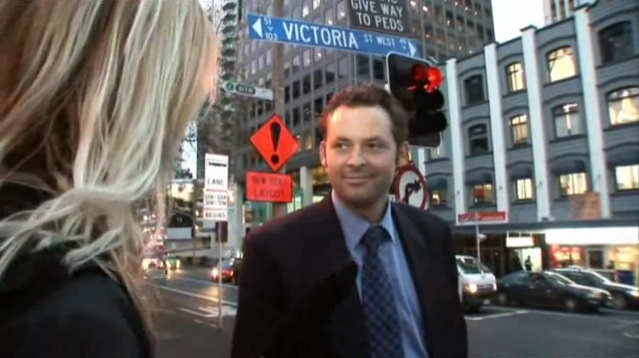
Instead, the quisling Crown Police Brass stayed true to their Colonial forebears – the Constabulary – authorizing the raiding of Rūātoki at dawn by invoking the Terrorism Suppression Act. In 1869, the Colonial Constabulary burned through Te Urewera in its relentless hunt for Te Kooti, who waged a guerrilla war against Colonial militia and had taken refuge in the Tūhoe wilderness. In the depths of winter, the Colonial Constabulary burned villages, shot ‘the natives’, destroyed crops, confiscated stored kai, and took prisoners to a camp. This incursion followed the 1863 Suppression of Rebellion Act, in-which its authors Freemason Premiere Bro. Frederick Whitaker and his law-firm partner, the Minister of Colonial Defence, Thomas Russell, framed Māori communities that did not submit to Queen Victoria as ‘rebels’, thereby constructing a mechanism of structural entrapment for the Crown to confiscate large tracts of Māori land, including tens of thousands of acres belonging to Tūhoe. Then, in 1893, Freemason Bro. Richard Seddon performed a ‘Sending in the Surveyors Ritual’ to the Ureweras. Predictably, in response to this brazen act of structural entrapment, Tūhoe pulled up Her Majesty’s survey pegs, thereby giving Seddon a pretext to deployed troops to the ‘crime scene’. Then, in 1916, armed police invaded Maungapōhatu to arrest ‘prophet of peace’ Rua Kenana, who appealed to his people not to enlist for the conflict that became known as World War I.[37] The intent of these incursions into Tūhoe territory was to smash a living example of Māori independence.
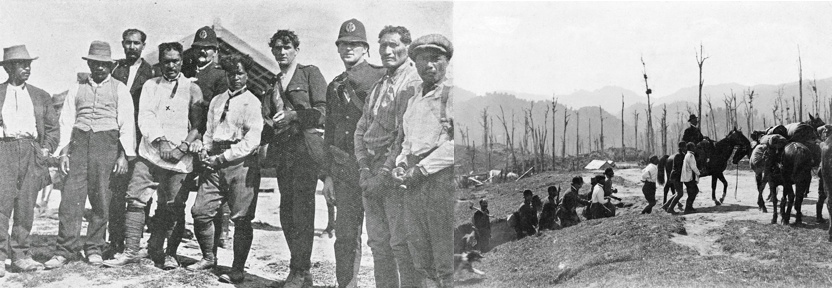
Therefore, Crown Prosecutor Mr. Burns was not interested in the Colonial Constabulary’s scorched earth policy of 1869 because the Solicitor General’s office was unwilling to consider the historical violence inherent to state formation. Police Commissioner Howard Broad was not interested in admitting how the wayward quest to gather ‘evidence’ of ‘military style’ training camps using the full range of surveillance capabilities was ironically about a political contest to defend the Crown’s stolen treasure – Te Urewera. Because, the Police Brass lacked the political courage, integrity and heart to stop being a criminogenic environment for the Crown’s power crimes! Crown Special Investigation Group Detective Sergeant Aaron Pascoe was not interested in hearing that the nuggets and gems his squad had gathered, added up to overblown politically motivated character assassinations – or verbalizing in police parlance – because he already knew it to be true.
The Thin Blue Line: Historically and Legally Blind
With straight faces, The Crown Police held to their line that they did not know about the Confiscation Line, its historical significance and why exactly Tūhoe’s staunch stance about independence was justified – to be at best willful ignorance – which is no excuse! It is pertinent to recall that Police charged Tame Iti for shooting a New Zealand flag on January 16 2005 on a Rūātoki marae – some two weeks after the incident – despite Police presence there at the time, as a result of an ignorant grandstanding demand by then-ACT Party parliamentarian Stephen Franks. Iti, who theatrically fired shotgun rounds at the flag, which was on the grass of the paepae during a powhiri at Tauraarau Marae, had earlier bared his buttocks to the Waitangi Tribunal delegation on the Confiscation Line, marked as it is with paint on the road, signs and – at the time – burning vehicles. The footage of the political theatre at the Confiscation Line was in the news stories of Tame Iti’s flag shooting. The Court of Appeal overturned the convictions for firearms offences in 2007.
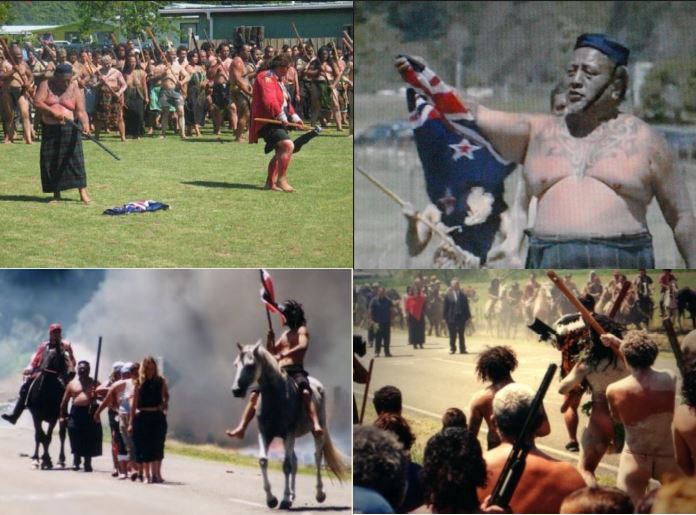
Ironically, when the Police came to Māori Television in 2005 with an order for copies of stories and footage of Tame Iti firing the shotgun, they were not interested in learning from staff about tikanga Māori, getting an education about the Crown’s theft of Tūhoe territory, or Māori jurisdiction over marae. In other words, if the Police Constabulary had have had an epiphany at the time it was pursuing its politically-motivated shotgun case against Tame Iti that was linked to the Constabulary’s participation in these historical crimes, it might have taken a public stance that these long-standing crimes against Tūhoe needed to be resolved without well-resourced malicious publicity. Moreover, the Police Constabulary’s active participation in terrorism, confiscation and murder in Tūhoe territory are among the many historical crimes that need to be taught in Crown Police training camps.
Burns, Broad and Pascoe were not interested in opening these cans of historical film and video-tape worms because they would have precipitated the collapse of the Crown’s fragile power. After-all, it is an Art of War strategy to appear strong when you are weak. In an interview with The New Zealand Herald in 2006, Tame Iti stated that Tūhoe’s claims with the Crown through the Waitangi Tribunal are not only about a return of stolen lands, but also about restoration of sovereignty. Iti added that the constitutional claim lodged with the Tribunal was not a stupid idea, citing the reality in Ireland, Wales and Scotland. In the winter of 2006, Tamati Kruger spoke of the struggle to restore said what the Colonial Crown stole, territory and sovereignty:
“The Crown wanted total and supreme sovereignty over the whole country. It would never accept partial sovereignty, nations within nations.
Essentially, we say that we are a sovereign nation and that the Crown and its agent, the Government, has no authority in our territory. It cannot point to any history or any event that would compel people to see that Tuhoe surrendered, resigned or ceded their sovereignty.”
Therefore, I think New Zealand Deep State succeeded in their dirty political attack on Tūhoe by controlling most of the symbolic ritualized actions.
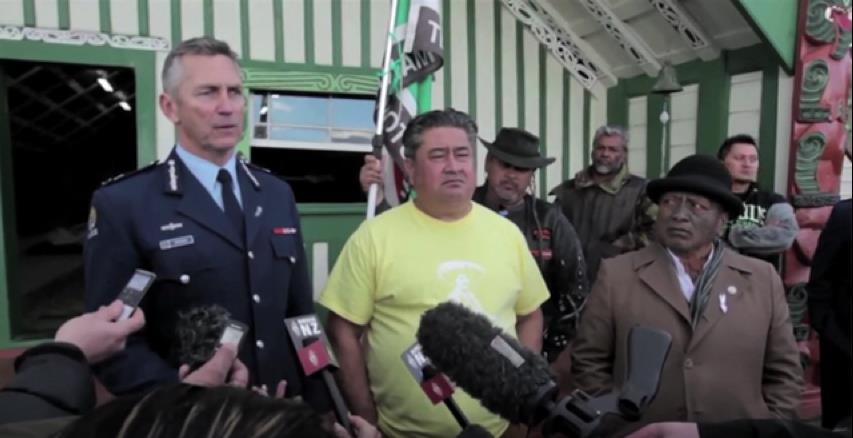
The task to apologize to the Rūātoki community over the raids for alleged military training camps in the highly symbolic Te Urewera Ranges, fell to new-Crown Police Commissioner Mike Bush. His predecessor, Peter Marshall, was forced to accept the Independent Police Conduct Authority’s findings that aspects of the Rūātoki raids and roadblocks were an unlawful marshalling.[38] The 13th of August 2014 apology was limited to causing trauma to innocent people caught up in the raids and the loss of credibility to the Tūhoe people, but not for the actual raids.[39] It was ironic that Mike Bush did not acknowledge the Deep State’s purpose for the over-the-top raids on Rūātoki as he spoke his scripted lines into the media microphones. Mike Bush’s limited concession before the microphones was ironic, given that by then a documentary titled, Operation 8: Deep in the Forest, had exposed that those accused of seeking to regain the bushy Ureweras through violent coercion had become pawns in an imperial chess game with far broader objectives. Those broader objectives involved reframing the wilderness as the location of paramilitary terrorist training camps, under the watch of Bush’s predecessor, Crown Police Commissioner Broad.
Crown Police Commissioner Mike Bush also unsoundly failed to acknowledge that Crown Police Commissioner Peter Marshall – with his Catholic Christian name and his law enforcement-sounding family name – in effect, embodied a Confession Ritual that set-up Mike Bush’s Cathartic Apology Ritual. In other words, the Deep State was continuing the defence of the protestant British Masonic Empire’s ironic deployment of the Discovery Doctrine, a Doctrine that the Roman Catholic Church had set in motion for European powers to conquer the New World in the 15th Century, as I have shown in my illustrated essay, “The Masonic New Zealand Wars”.[40] Thus, by dividing New Zealand into two predictable emotively charged camps – pity and fear – the Deep State exploited a complicit Pākehā-dominated media as a vector for emotional contagion.
In these deceptive ways, the Crown Constabulary exploited known fault-lines of the staunch Tūhoe rangatiratanga worldview and numerous grassroots causes, to open race and status divides. Thus, Howard Broad’s claims that the Operation Eight raid on Rūātoki was not racist because elsewhere they had targeted Pākehā – did not hold up to scrutiny.
Therefore, the Crown Police Special Investigation Group at Auckland’s Metro Crime Services provided a ritualized ‘mass service’ of framing 17 people in a criminal plot, terrorizing hundreds in dawn raids and orchestrating a nationwide B-Grade scripted psy-op to justify the budgets, power and legitimacy of Police State formation against a background of similar incursions around the world. Indeed, in Operation 8: Deep in the Forest, former Police Inspector Ross Meurant likened the Police Force to a “forest” with paranoid élite Police squads that frequently construct cases for prosecution based on “bullshit” deductions from deep in that forest. Meurant mockingly said the special investigation squads think they are the CIA of New Zealand.
The foregoing phenomena of a well-resourced B-Grade scripted pre-emptory and peremptory actions neatly captures the recalcitrance, repugnance, and recidivism of the Pākehā ruling class and the Neo-Colonial Crown towards political moves by Māori to make Māori sovereignty aspirations materialize. Occasionally those moves by Māori political actors are B-Grade movie ideas, like Tame Iti’s call for an uprising at the Parihaka Peace Festival.
It is, therefore, epically ironic that the Police set-up Special Investigations Groups (SIG) in 2005 with the justification given by the Minister of Defence, Phil Goff, that they would boost New Zealand’s counter-terrorism capacity because of perceived threats after post-9/11. This 9/11 justification assumes that the official B-Grade 9/11 narrative of Jihadi Al Qaeda terrorists hating America’s infidel freedoms is taken to be true. Which means the New Zealand state is either a dunce when it comes to 20th Century history and its intelligence apparatus is naïve. Or, it means the SIS and the New Zealand state do know that the US-UK-NATO Alliance have their own Deep State terrorist networks. In their accounts of the post-World War II order, journalists such as John Pilger and Naomi Klein, and documentary filmmaker Eugene Jarecki, along with US foreign policy critic Noam Chomsky, have shown that the US-UK-NATO Alliance has routinely conducted acts of terror.[41] These Black Operations, as they are called, have occurred in over 50 countries and were often conducted to topple democratic socialist governments or communist states in Europe, Central and South America, South East Asia, the Middle East and Africa. After World War II, the Atlantic Alliance covertly formed a secret ‘stay behind’ army by recruiting fascists, including former Nazis, to conduct terrorism operations codenamed ‘Gladio’ (Latin for Roman sword). As I mentioned earlier, Operation Gladio was a low-grade war that exploited a “Strategy of Tension” designed to frighten the mass populaces of Europe and thereby shift the political gravity to the ‘right’.[42]
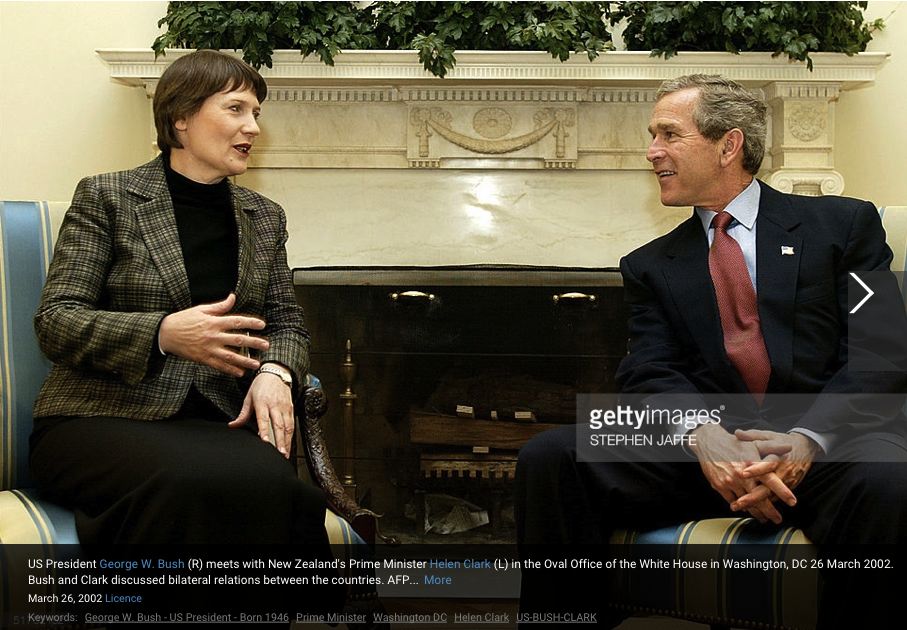
These clandestine ‘false flag’ operations were continued by all NATO countries after its formation in 1949, and were carried out by their intelligence services, militaries, and paramilitaries, with dominant participation from the Anglo-American membership of NATO, as Daniele Ganser presented in his book, NATO’s Secret Armies: Operation Gladio and Terrorism in Western Europe; Richard Cottrell shows in his book GLADIO: NATO’S Dagger at the Heart of Europe – The Pengtagon-Nazi-Mafia Terror Axis; and Madhi Darius Nazemroaya reports in his book The Globalization of NATO. These studies of GLADIO found that occult secret societies were entwined into the Gladio network. Therefore, New Zealand’s Police-Intelligence-Surveillance-Security State apparatus is aligned with the US-UK-NATO Alliance, who had augmented their power through terrorism. As Dr Vijay Devas said, keeping the ‘war on terror’ going endlessly suits the interests of the state, because it maintains a “state of Exceptionalism”, wherein the normal rule of law is suspended to a crisis operational matrix.
The state needed to undermine Tūhoe’s mana ahead of negotiating with the iwi because there was a risk that if Tūhoe played its cards well, the tribe could have wrested sovereign ownership and control of their former territorial possessions from the Crown. If this had occurred, all other iwi would likely have followed suit, leading to rapidly diminished Crown power and catastrophic collapse. Ironically, in pursuing this case for almost seven years – from the day of the dawn raids to the early release of the prime target, Tame Iti – the Police, the Crown’s Solicitor General’s Office, Her Majesty’s judiciary and two Government Administration’s have participated terrorist acts, vexatious criminal proceedings and a conspiracy to accumulate more political power. This ‘Operation Eight Plot’ that was inflicted to intimidate the populations of Rūātoki, Tūhoe, various activist groups and the wider New Zealand population – was in breach of the section 240 of the Crimes Act of 1961, which deals with crimes of deceit. Furthermore, the crises created for the communities of Rūātoki, Taneatua and Tūhoe, in general, drew resources, time and thoughts away from resisting the Crown, with their legitimate efforts for the return of stolen and swindled lands and requisitioned to support the victims, and battle court cases over Crown Police charges.
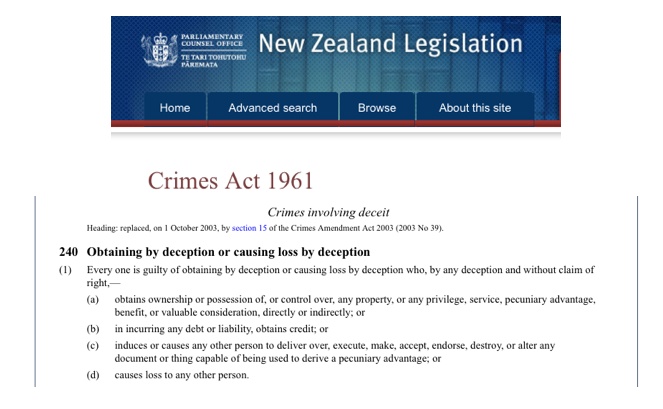

Treaty Settlements Minister and Attorney General Chris Finlayson would have to be legally blind not to see the B-Grade movie narrative of these Deep State schemes. I am saying that once he became Attorney-General, Chris Finlayson failed to order an inquiry into the Rūātoki raids, that could have laid bare a bigger nuanced picture. Tame Iti was also teaching tikanga Māori, such as the traditional use of the taiaha, bush-craft, and waiata. These aspects of the wananga did not fit the terrorism narrative, so the Crown prosecution ignored those aspects. Detective Sargeant Pascoe admitted in court that he did not know much about tikanga Māori, but that he did know it would be insensitive to set-up a roadblock on the Confiscation Line. His message evidently did not make it through to the top brass.
Indeed, indigenous rights lawyer Moana Jackson underlines the political conspiracy against the Rūātoki community and Tūhoe ahead of negotiating with the Crown:
“Of all the areas that were raided by the police on that day, Ruatoki was the only one that was locked down, Rūātoki was the only one where helicopters flew overhead, Rūātoki was the only one where innocent people were stopped on their way to work, where buses carrying pre-school children were stopped and so on.
“Tūhoe were at the time [of the raids] engaged in negotiations over the return of raupatu [confiscated) land. I think a clear part of the strategy behind the raids was to send a message that there were limits to what the Crown was prepared to do.”[43]
Tūhoe leader Tamati Kruger stated in Operation 8: Deep in the Forest, that the police raid on Rūātoki:
“was a show of force. It was literally at gunpoint … at gunpoint, reminding Tuhoe who was in charge here.”
In her review of Errol Wright’s and Abi King-Jones’ Operation 8 – Deep in the Forest documentary published in the State Crime Journal, Stéphanie Bürgenmeier noted that Massey University counter-insurgency expert, Dr Jeff Sluka, had told the Operation 8 filmmakers that since the rise of the ‘New Right’, the New Zealand government had pursued a course to suppress dissent by criminalizing it. The state’s goal was, “to redefine essentially political opposition and resistance as terrorism”, Sluka said.
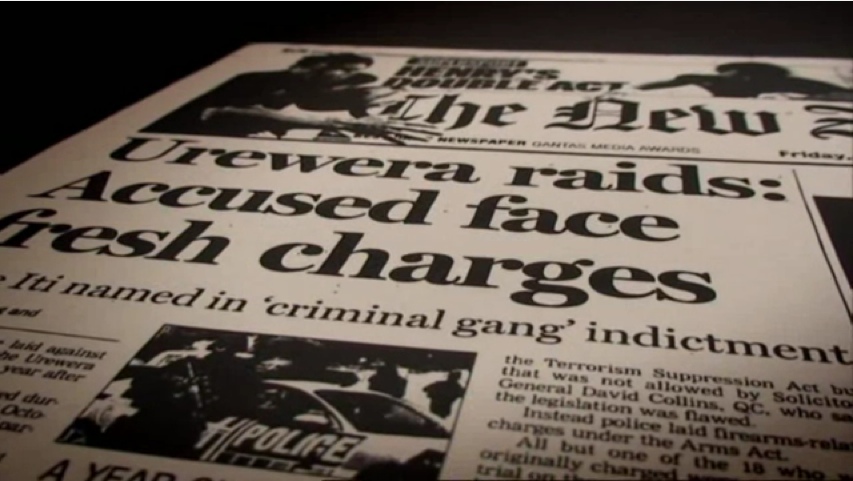
It is fascinating, therefore, to recall that prior to the Urewera Four trial commencing on February 13th 2012 – three weeks after the Dotcom Police Raid – Crown Prosecutor Ross Burns was ‘helicoptered in’ to save Neo-Colonial Capitalism from an Occupy Movement protest group camped below the Auckland City Council’s HQ in December 2011. The news media reported Mr Burns, who was representing the council at the Auckland District Court, expressing concern that the ‘anti-capitalist’ encampment from causing the grassroots to die. The Deep State darkly satirical humour appeared to go over the heads of the activists. In other words, the Deep State’s flavour of the month prosecutor – Mr Burns – who conveniently ignored the Crown’s scorched earth policy toward Tūhoe, is ‘helicoptered in’ from the Urewera trial, to tell the court that the Council is concerned the grassroots are dying off. This surface concern for the grass and its root was due to a small number of activists exercising their Bill of Rights to protest in solidarity with the global Occupy Movement on a grassy patch by Aotea Square. In short, the Council was signalling it too was advancing the game in solidarity with the Deep State, by ‘helicoptering in’ Mr Burns. The encoded symbolism was communicating that even peaceful demonstrations – with not a hint of violence – were under attack, and that it was intention of New Zealand’s Pākehā-dominated ruling class to kill off grassroots movements, against a backdrop of a multi-season psy-op complete with a fake napalm defoliant threat scripted by the Department of Pre-Crime.
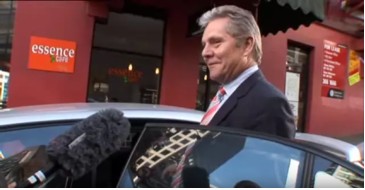
Tame Iti’s B-Grade ‘freedom-fighter’ uprising idea provided the opportunity for the Crown’s Deep State to construe his bush wananga as a “private militia in formation” – in Judge Hansen’s words. This view was arrived at, through circumstantial evidence and illegal surveillance recordings re-constructed out of context by the Police SIG unit, and without consideration for the underbelly of machinations that had already been partially exposed by Abi King Jones’ and Errol Wright’s documentary, Operation 8: Deep in the Forest. Justice Hansen’s view was so predictably inadequate – it was as if it were conceived by a B-Grade psy-op script-writer.
In other words, the Crown has brazenly granted a concession – a fee simple feudal estate title supposedly in perpetuity for ‘the natives’ of Tūhoe to have board positions. Tūhoe have essentially been conferred limited neo-feudal rights as park rangers over lands the Crown stole!
Indeed, the one-eyed scape-goat casting of Māori as rebels has become such a cliché in the New Zealand Tax Farm, that the Crown Solicitor General’s Office – which is charged with overseeing the legitimacy of cases – showed it was ‘incapable’ of apprehending the State’s own subversive actors whose obvious coercion underpinned the dawn raids. Not only had the Crown deployed a fraudulent stratagem to trick the New Zealand people through the device of hundreds of charges – including the Terrorism Suppression Act – for effect. Inherent to this B-Grade psy-op plot was coercion through blackmail. The Deep State actors and script writers behind this scheme sought to coerce Tūhoe into lowering their expectations with reference to negotiating with the Crown, and diminish its mana among the tribes of New Zealand.

As can be seen from section 237 of the Crimes Act of 1961, the over-the-top dawn raids – in particular at Rūātoki – amounted to blackmail because the heavily armed police threatened the safety of people for the pecuniary advantage, privilege and valuable consideration of the Crown to exercise its unlawful and fraudulent right to be sovereign. The implied threat was that if those assailed by the police did not submit, then they would be harmed, since the heavily armed police entered properties either by force or threat of force. The dawn raids were designed to spread fear throughout the Rūātoki community, the wider New Zealand activist communities, and the mass populace.
This spreading of a fake threat of an armed militia training to use violence to coerce the Crown to return Tūhoe lands, including Te Urewera, threatened the safety of the Rūātoki community, the homes of other activists arrested and the wider New Zealand society. If these malicious disproportionate events had have gone wrong, say with people putting up a legitimate fight to defend their homes from such unlawful incursions, then people could have died or been seriously injured by the police gang’s gunfire.
Furthermore, the Police actions – sanctioned by the Crown – have undermined the safety and legitimacy of New Zealand’s activists, by making false accusations with the spectacle of forced entries to homes. Through this coercion, the police have blackmailed New Zealanders with a demonstration of surveillance, armed dawn raids and the lock-down of a rural community – in order to undermine so-called left-wing causes, Tūhoe‘s right of undisturbed possession of lands, dwellings and businesses, and the lawful customary right of he tangata Māori to exercise sovereignty.
The Crown’s process to settle with Tūhoe was concurrent with the Queen’s case against the ‘Urewera Four’. Conjuring the spectacle of a Māori rebellion was as much about undermining Tūhoe’s credibility going into the process of negotiating with the Crown, as it was about signalling to the Pākehā-dominated ruling class – who are attuned to dog-whistling – that the fix was in. The Pākehā-dominated Establishment Media – for the most part – could be relied upon to act as vectors for the transmission of emotional contagion. The Liberal Class could be relied upon make some muffled noises about the racism inherent to the raids. And the judicial system could be relied upon to focus on the wrong-doing of the accused – because this ‘Switzerland of the South Pacific’ is a hollow society.
In a lecture at the University of Auckland on the evening of Halloween 2017, Tāmati Kruger stated Tūhoe have been:
“disrupted by 177 years of colonization” and remain “an unsettled people” who have endured “great damage to [their] whakapapa, to that link, over 177 years. The Crown, he said, was a machine that has an “instinct … to control and dominate, irrespective of what you have written in your settlement, irrespective of what you have in your legislation. This machine has an instinct to control, and to boot, it has no memory of what it promised you last week.”
Operation Eight: A New Zealand COINTELPRO Program?
The Operation Eight assignment was, in effect, the equivalent of the FBI’s seven COINTELPRO programs that operated in the 1960s and early 1970s to undermine dissent. Evidence of the CONINTPRO programs were discovered as a result of official information requests following the 1971 break-in of a FBI field office in Media, Philadelphia by nine people who sought documents proving FBI infiltration of dissident groups.
The Prime Minister at the time of the Operation Eight raids, Helen Clark, framed the raids for her own political ends to bolster her credibility in the aftermath of the other ‘security issue’ – the Ahmed Zaoui case and heading into election year. Clark said in a speech at a Labour Party conference, “The mere thought of paramilitary training in the Ureweras by disaffected people of many ethnicities is distressing and abhorrent to our people.”[44]
Clark’s predominantly Pākehā audience applauded her over-simplifications and brazen deflection from the structural dispossession of land endured by Tūhoe and other Māori iwi and hapu. This propaganda line from a prime minister and the political head of New Zealand intelligence services was all the more brazenly manipulative, given that under her watch former Algerian politician and political asylum seeker Ahmed Zaoui had been wrongly jailed. Indeed, Clark’s failure as the country’s top lawmaker at the time to be skeptical, belies a ‘meeting of minds’ that the raids would be a good psy-op to augment more power.
Indeed, questions remain for the Parliamentary Subpoena Committees and the Intelligence and Security reference group panel. What were the exact roles of private investigator firms, such as Thompson and Clark, police informant Rob Gilchrist and the Auckland Metro Crime Services Special Intelligence Group? Did anyone act as an agent provocateur, to encourage Tame Iti that an uprising was good idea – so that it could be construed that he was planning a violent rebellion? Why all the subsequent resignations of heads at Police HQ, the Solicitor Generals’ Office and at the SIS?
Fascinatingly, Justice Hansen and Justice Brewer failed to rebuke the Crown for failing to fess up to New Zealanders about its refusal to hand-back Crown held-Tūhoe land, the Deep State’s daily structural violence of Shock Doctrine economic warfare,[45] and its incessant brainwashing psychological warfare. Justice Hansen’s remarked that violent means to achieve the laudable ends is not justifiable. What I find troubling is that Justice Hansen, Justice Winkelmann and Justice Brewer failed to call out Pākehā Special Investigation Group Detective Sergeant Aaron Pascoe, Police Commissioner Howard Broad and Crown Prosecutor Ross Burns for conspiracy to frame so many for a non-existent terrorist plot, when the forgoing Crown plots to pervert the pursuit of a just society were real, vicious and systemic.
It is also fascinating to see in Operation 8 that then-NBR editor Neville Gibson stated in the aftermath of Hager’s Gilchrist police informant scoop of late 2007, that such infiltration tactics were needed to protect commerce because unless there were consequences, activists would get carried away with their “Jihadist” worldview. Therefore, the nexus of the Police ‘forest’, its ties to private investigator firms, such as Thompson and Clark; pro-Rich-Lister Establishment Media outlets such as the National Business Review and their links to the Neo-Colonial corporate world; and the Crown’s links to the British Civil Oligarchy – including the Monarchy and the privately-owned municipal City of London Corporation secrecy haven – remained unexamined.
Even though the Crown’s Solicitor General’s Office, two courts and, indeed, the Police Special Investigations Group knew no planning had occurred and therefore there was no immediate threat, the judiciary entertained this B-Grade psy-op. It was in this way, the Crown pursued a deceptive strategy that breached section 240 of the Crimes Act of 1961 to attack Tame Iti’s credibility. While Iti was out of the way, the Crown gained a ‘compromise’ agreement that gave Tūhoe the impression that their more moderate negotiators had got the best deal they could wrangle: a fee simple title for Te Urewera that is subject to tax.

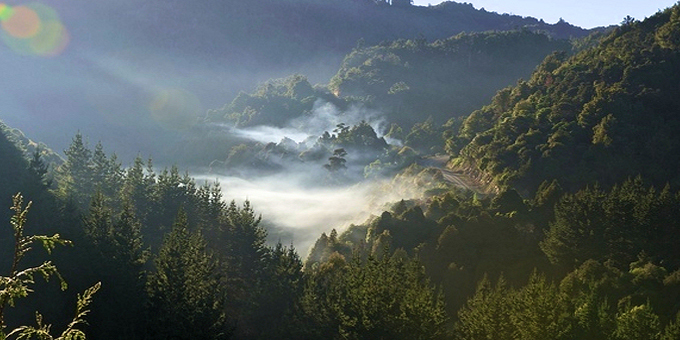
In the aftermath, the standing of Tame Iti, Tūhoe, and left-wing political activism were diminished. These attacks are located in a sharpened historical context, specifically that the raids and confiscations of Tūhoe lands occurred as part of violent state formation processes that included the application of a little known piece of international law known as the Doctrine of Discovery. New Zealand in the colonial era became a Masonic territory of the British Masonic Empire. This missing piece of the puzzle of New Zealand’s history shows that the Crown’s claims as sovereign are not only epically fraudulent.
It also shows that the violent processes of state formation are ongoing, as New Zealand’s political, economic and cultural trajectory is steered along to entangle institutions. communities and families into a Global Smart Grid Green Economy, where even Te Urewera ancestral lands of Tūhoe are expected to pay tax. I detect that the Tūhoe members of Te Urewera’s board have been unwittingly cast as carbon sink bio-reserve park rangers expected to pay carbon taxes and collect carbon credits. I conclude that New Zealand can expect more B-Grade terror psy-ops when – not if – New Zealand’s Deep State perceives the need to attack the credibility of its perennial scapegoat – Māori – to resolve more crises that threaten Pākehā ruling class power.
The Crown’s Deep State dark satirical humour is evident in the unwritten logic and unspoken subtext in-built into the B-Grade-Dawn Raid-Court Room-Bubble Gum News Psy-War. The casting of less than a handful of Tūhoe representatives in this settlement as bio-reserve park rangers on a Neo-Colonial board, and the eventual re-casting of Tuhoe’s ancestral lands as a carbon sink for earning carbon credits and charging carbon tax tolls.
The state’s attitude toward political dissent is clear. As political analyst and political science lecturer at Auckland University Dr Paul Buchanan said in Operation 8: Deep in the Forest, the raids were designed to stifle dissent by dragging the costly cases on for years, thereby acting a deterrent to would-be activists, all for charges found to be contrived.
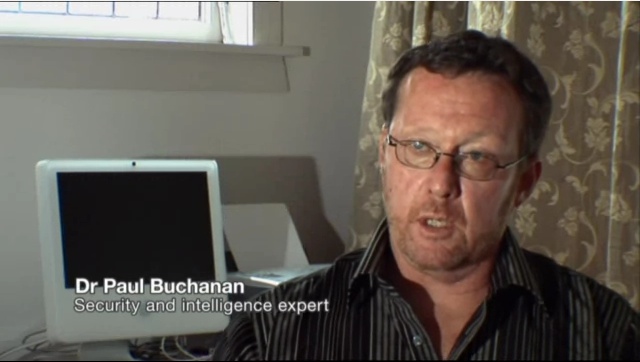
In effect, the Auckland Crime Metro Crime Services had recast itself as Oceania’s Fiction Department in a Ninety Eighty-Four universe, its SIG unit as the Rewrite Squad authoring a frame-up job. Operation Eight was a News Special that ran for five seasons. In a country where the television industry is starved of resources to make the kind of B-Grade darkly satirical political thriller that was marketed as ‘based on a true story’, the plot, sub-plots and web of characters of Operation Eight show that NZ Deep State Inc. maintains a monopoly hold over ‘entertainment’ on behalf of National Security Interests. In the warped logic of Deep State power, Morse’s secular sin – daring to write her thesis Against Freedom: The War on Terrorism in Everyday New Zealand Life – had to be countered with a fictional work, too. It is poignant to note that in the chapter “Dissent”, Morse quoted Randolph Bourne who wrote just after the so-called First World War ended:
“War is the health of the state. It automatically sets in motion throughout society those irresistible forces for uniformity, for passionate co-operation with the government in coercing into obedience minority groups and individuals. The machinery of government sets and enforces the drastic penalties, the minorities are either intimidated into silence, or brought slowly around by a subtle process of persuasion …”
Morse followed this quote from the 1977 edition of Anarchist Reader with her own thoughtcrimes:
“Thoughout history, one of the most debated and struggled for rights in any society has been the right to disagree with, or dissent from, the majority view. This is particularly true in times of war. Government has long worked to control, manage and suppress dissent. Dissenters have been cast as violent, crazy or exceptionally rare. In the post-September 11th environment, dissent is portrayed as a form of terrorism.”
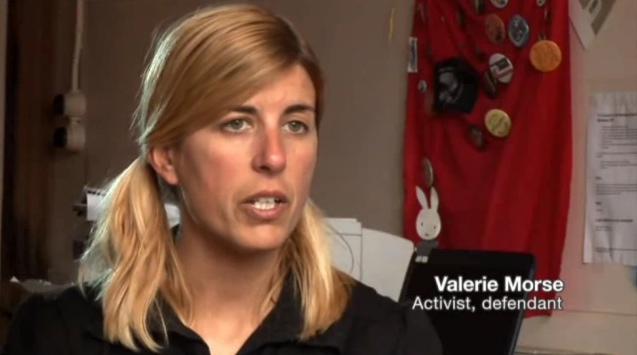
The Rūātoki raids were part of a longer continuum to “homogenize” Tūhoe, this time by brainwashing New Zealanders with an unbalanced enemy image that lacked a proportional, level-headed and historically-honest response. Instead, New Zealanders were dished the Neo-Colonial State’s calculated subversive political conspiracy, a re-enactment of historical incursions into Tūhoe territory. The unwillingness of the New Zealand Neo-Colonial State to educate the populace about it’s own acts of terror against so-called rebellious Maoris, its subjugation of pacifist Māori communities and its exploitation of Māori in the ongoing ‘Global War of Terrorism’ waged by the Fascist Internationale Deep State – and instead opted to wage a nationwide B-Grade psy-war, shouts loud like an Orwellian ‘Two Minutes Hate’ session in the story of the Operation Eight raids.
Meanwhile, prior to the Urewera Four trial commencing on February 13th 2012, Crown Prosecutor Ross Burns was ‘helicoptered in’ to save Neo-Colonial Capitalism from an Occupy protest camped below the Auckland City Council’s then-HQ in December 2011. The news media reported Mr Burns, who was representing the council at the Auckland District Court, expressing concern that the anti-capitalist encampment from causing the grassroots to die. The Deep State’s darkly satirical humour appeared to go over the heads of the activists, including the late-Penny Bright. The Deep State’s flavour of the month prosecutor – Mr Burns – who ignored the Crown’s scorched earth policy toward Tūhoe, is ‘helicoptered in’ from the Urewera trial, to tell the court that the Council is concerned the grassroots are dying off due to a small number of activists exercising their Bill of Rights to protest in solidarity with the global Occupy Movement. In short, the Council was signalling it too was advancing the game in solidarity with the Deep State, by ‘helicoptering in’ Mr Burns. The encoded symbolism was communicating that even peaceful demonstrations – with not a hint of violence – were under attack, and that it was intention of New Zealand’s Pākehā-dominated ruling class to kill off grassroots movements, against a backdrop of a multi-season psy-op complete with a fake napalm defoliant threat scripted by the Department of Pre-Crime.
Another hallmark of a Deep State black operation is the recurrent appearance of the number 13, as I stated earlier. The planting of Thirteen and its multiples as mundane data into events, signifies the presence of a ‘Fraternity’, for whom the number 13 signals ‘unity and love’. This occult practice was embedded in New Zealand during the colonial era,[46] and telegraphs the direction the Deep State is taking and where it has been.
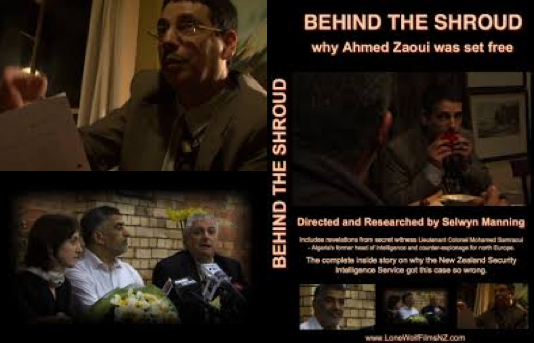
To this criminal end, the Director of the NZ Security Intelligence Service, Warren Tucker, suppressed Lieutenant Colonel Mohamed Samraoui’s part in framing Ahmed Zaoui in his communiqué of September 13th 2007. SIS Director Tucker insinuated that Zaoui had been guilty of “participating in and leading terrorist networks” in France and Belgium, and claimed that his deportation from “Switzerland for issuing statements supporting violence in Algeria and attracting extremists” were legitimate records of Zaoui’s life. Thus, with this deceptive September 13th 2007 communiqué, the SIS telegraphed where they had been, and the direction the NZ Deep State were taking, by making a public statement exactly one year after the profiles of all of Tame Iti’s associates had been logged as evidence into the Operation Eight case file, on September 13th 2006.
Approximately one month later, on 15 October 2007, the commencement of the ‘Termination Phase’ occurred, exactly 13 months after the first of numerous call data warrants were sought to obtain telephone metadata and text messages, which was, in essence, the date – 15 September 2006 – when the nationwide search for a terrorist network began. On 6 September 2011, charges against 13 of the 18 accused were dropped. In the case that eventuated against the ‘Urewera Four’ – which commenced on February the 13th 2012 – the judge permitted the use of the illegally gained video, audio and photographic surveillance recordings, even though the Supreme Court has suppressed their use.
On February the 26th 2013, the Parole Board announced it was releasing Tame Iti from prison. On the 13th of August 2014, new-Police Commissioner Mike Bush performed a Meā Maxima Culpā Catharsis Ritual limited apology for the Police causing trauma to innocent people caught up in the raids and the loss of credibility to the Tūhoe people, but not for the actual raids.[47] Thus, Commissioner Bush was, in effect, signalling that the Deep State had camouflagued its covert role to maintain substance of possession over Tūhoe territory, including Te Urewera, and telegraphing the direction of the Deep State: more black operations on the horizon.
Curiously, few New Zealanders across the political spectrum, including those with public profiles – who supposedly value freedom, free speech and fairness – spoke out about the obvious ulterior motives, inconvenient truths and callousness exacted by the state apparatus.
To sum up, the Crown signed off on this political conspiracy, and through its enjoinable conduct with the Police’s Operation Eight, embroiled more participants in a furtherance of conspiracy that can be traced to the multi-season psy-war to frame Algerian-born political asylum seeker, former politicians and academic – Ahmed Zaoui.
As I outlined in the previous article – “Psy-warfare from Zaoui to Iti to Dotcom: Part 1 — Lt. Colonel Samraoui’s character assassination of Ahmed Zaoui” – the Crown’s case against Zaoui collapsed following the secret witness testimony given by Algeria’s former head of intelligence and counter-espionage for northern Europe, Lieutenant Colonel Mohamed Samraoui. This potential bombshell meant the national security state had lost their ‘poster boy’ for the ‘Global War on Terror’ in New Zealand. By being forced to free their ‘poster boy’, the national security state faced a looming crisis of legitimacy at a time when amendments to the terrorism Suppression Act were before a parliamentary select committee. This credibility crisis converged with the Crown’s looming crisis that it had zero legitimacy to deny Tūhoe the return of the Urewera wilderness. To confront this convergence of crises, the Crown’s Deep State deftly deployed its scripted B-Grade multi-season News Special psy-op – Operation Eight and was effective enough to achieve its broad objective – to save the realm from a catastrophic collapse of Crown credibility, control over the Native Estates and perceived right to inflict Shock Doctrine psy-warfare.
==========
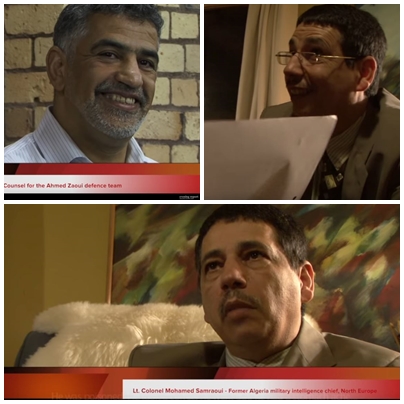
“Psy-warfare from Zaoui to Iti to Dotcom: Part 1 —
Lt. Colonel Samraoui’s character assassination of Ahmed Zaoui”
at: https://snoopman.net.nz/2018/10/17/psy-warfare-from-zaoui-to-iti-to-dotcom-part-1/
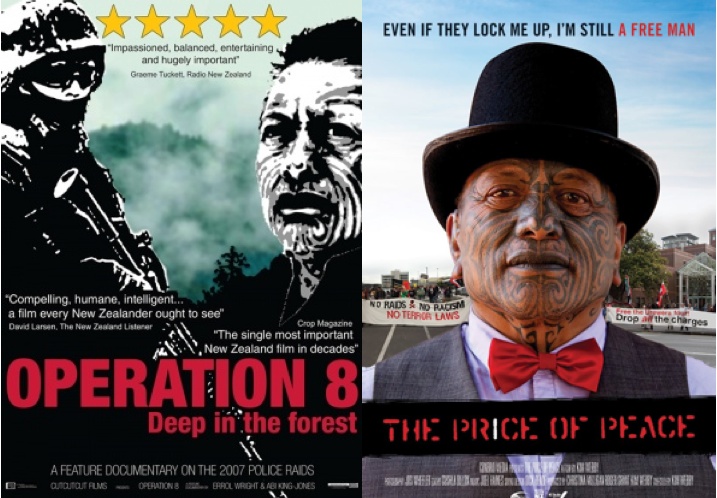
Operation Eight Raids: De-risking Crown Sovereignty Loss
at: https://snoopman.net.nz/2019/10/15/operation-eight-raids-de-risking-crown-sovereignty-loss/
Christchurch Mosques Attack Riffed off Netflix’s Secret City?
https://snoopman.net.nz/2019/06/04/christchurch-mosques-attack-riffed-off-netflixs-secret-city/
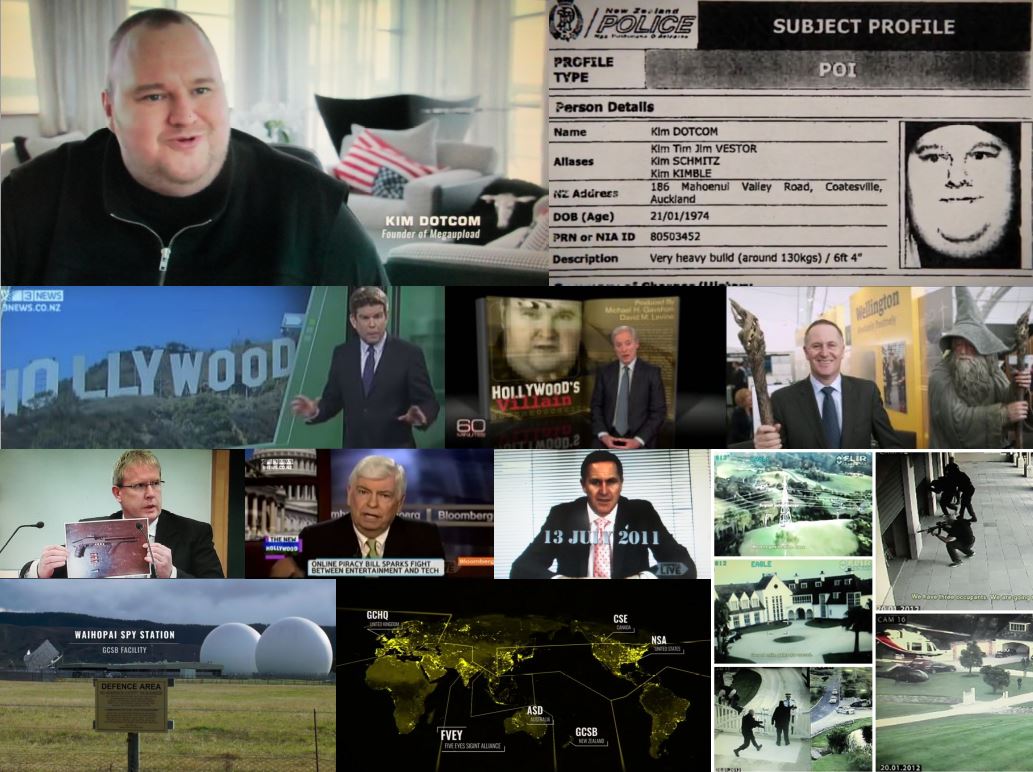
Psy-warfare from Zaoui to Iti to Dotcom: Part 3 – Hollywood’s make-believe villain, Kim Dotcom (alias Kim Kimble)
Source References:
[1] Operation 8 – Deep in the forest – Aotearoa (New Zealand). Retrieved from https://www.youtube.com/watch?v=pKksGWyB24g; A picture of terror in the Ureweras By Peter Calder 5:30 AM Saturday Apr 16, 2011http://www.nzherald.co.nz/nz/news/article.cfm?c_id=1&objectid=10719596
[2] Snoopman. (October 16, 2018). Psy-warfare from Zaoui to Iti to Dotcom: A Three-Part Investigation. Retrieved from https://snoopman.net.nz/2018/10/16/psy-warfare-from-zaoui-to-iti-to-dotcom/
[3] Aleister Crowley. (1986). Liber 777, xxv; “An Essay Upon Numbers”. In: Israel Regardie (Ed.). (1994). 777 and Other Qabalistic Writings of Aleister Crowley, p.29. York Beach, Maine; USA: Samuel Wesier Inc.; W. Wynn Westcott. (1911). Numbers: Their Occult Power and Mystic Virtues, p.109.
[4] DRAFT SIEMER V THE SOLICITOR – GENERAL COA CA607/2011 [11 May 2012] IN THE COURT OF APPE AL OF NEW ZEALAND https://www.indymedia.org/media/2012/05//956746.pdf
[5] Fran O’Sullivan. (1 April 2011). Protect our basic right to trial by jury – NZ Herald. Retrieved from https://www.nzherald.co.nz/nz/news/article.cfm?c_id=1&objectid=10716484
[6] Video Camera Surveillance (Temporary Measures) Bill 2011, s 3. The Bill was heavily criticised during the Select Committee stage. For more information see Samuel Beswick and William Fotherby ―Surveiling the Stopgap‖ [2011] NZLJ 404, at 405.
[7] Dr Rodney Harrison: Why Govt plan to overrule top court is wrong – NZ Herald. Retrieved from https://www.nzherald.co.nz/opinion/news/article.cfm?c_id=466&objectid=10753685
[8] Crimes Act 1961. Section 240. Crimes involving deceit 240. Obtaining by deception or causing loss by deception. Parliamentary Counsel Office. New Zealand Neo-Colonial Government. Retrieved from http://www.legislation.govt.nz/act/public/1961/0043/latest/DLM330275.html
[9] Steve ‘Snoopman’ Edwards. (October 17 2017). Weaving Quilts: How & why Tame Iti’s ‘Uprising’ Fantasy fed the NZ Deep State’s B-Grade Five Season Terror Plot Frame-up Job. Retrieved from https://snoopman.net.nz/2017/10/17/weaving-quilts-or-why-tame-itis-uprising-fantasy-fed-the-states-b-grade-terror-plot-frame-up-job/
[10] THE TERRORIST FILES http://www.nzcpr.com/wp-content/uploads/2013/01/TheTerrorismFiles_DomPost141107.pdf; The Urewera raids: Breaking the story. Retrieved from http://www.stuff.co.nz/national/64348692/the-urewera-raids-breaking-the-story; Patrick Gower. (September 16, 2008). Media chiefs appear in ‘terror files’ case. Retrieved from http://www.nzherald.co.nz/nz/news/article.cfm?c_id=1&objectid=10532377
[11] Errol Wright and Abi King-Jones (2012). Operation 8 – Deep in the forest – Aotearoa (New Zealand). CutCutCut Films
[12] Wright and King-Jones (2012). Operation 8. CutCutCut Films.
[13] Juliet Rowan. (12 March 2008). Accused wins fight over court location in terror raids case. Retrieved from https://www.nzherald.co.nz/nz/news/article.cfm?c_id=1&objectid=10497842
[14] Ian Steward. (7 September 2011). Urewera raid case a ‘house of cards’. www.stuff.co.nz/national/crime/5576232/Urewera-terror-raid-case-a-house-of-cards
[15] Morse said in the documentary Operation 8 that she would likely have to mortgage her house to finance the legal battle. Other are still struggling with the legal bills, trauma and broken trust. See: Cleo Fraser and The Hui Staff. (15/10/2017). Urewera Raid arrestees still struggling with legal bills/ http://www.newshub.co.nz/home/new-zealand/2017/10/urewera-raid-arrestees-still-struggling-with-legal-bills.html
[16] Stéphanie Bürgenmeier (Autumn 2013) Review: Operation 8: Deep in the Forest by E. Wright and A. King-Jones State Crime Journal, Vol. 2, No. 2 pp. 205-209. Retrieved from http://www.jstor.org/stable/10.13169/statecrime.2.2.0205
[17] Maiki Sherman. (23 March 2013). Tūhoe sign Deed of Settlement. Retrieved from http://www.maoritelevision.com/news/regional/tuhoe-sign-deed-settlement
[18] Audrey Young. (11 Sep, 2012). Tuhoe sign $170m settlement with Crown. https://www.nzherald.co.nz/kahu/tuhoe-sign-170m-settlement-with-crown/C7MGIH2PTC2C4354BSGDY3MGUA/; Tame Iti has ‘matured’ in prison 26 Feb, 2013 https://www.nzherald.co.nz/nz/tame-iti-has-matured-in-prison/OQYHIHMSLQ43WUC3AOMM4JSPVA/
[19] In her book Builders of Empire: Freemasonry and British Imperialism, 1717-1927 Jessica Harlands-Jacobs states Captain Cook was a Freemason. Harlands-Jacobs was the keynote speaker at the 300th Anniversary of British Freemasonry.
[20] Ivison, D., Patton, P. & Sanders, W. (2000). Political Theory and the Rights of Indigenous Peoples.Cambridge, United Kingdom: Cambridge University Press; Miller, R. J. Ruru, J. Behrendt, L. & Lindberg. (2010). Discovering Indigenous Lands: The Doctrine of Discovery in the English Colonies. NY: Oxford University Press; Silver, M., Pugh, M. & Harry, D. (2003). The Leech and the Earth Worm. [Motion Picture]. Nevada, USA: IPCB Production. Retrieved from http://www.ipcb.org/publications/video/files/film_project.html
[21] David Ausubel (1960). The Fern and the Tiki: An American View of New Zealand National Character, Social Attitudes and Race Relations, p. 206. Ellington, NZ: Angus & Robertson.
[22] Talisa Kupenga. (19 May 2017). Te Urewera management plan future of conservation – Kruger. http://www.maoritelevision.com/news/national/te-urewera-management-plan-future-conservation–kruger
[23] New York Times. (13 July 2016). In New Zealand, Lands and Rivers Can Be People. Retrieved from http://www.ngaituhoe.iwi.nz/In-New-Zealand-Lands-and-Rivers-Can-Be-People
[24] Māori Law Review (October 2012). Crown offer to settle the historical claims of Ngāi Tūhoe http://maorilawreview.co.nz/2012/10/crown-offer-to-settle-the-historical-claims-of-ngai-tuhoe/
[25] Law Commission (June 1992). “Tenure and Estates in Land”. Preliminary Paper No 20, June 1992 Wellington, New Zealand https://www.lawcom.govt.nz/sites/default/files/projectAvailableFormats/NZLC%20PP20.pdf
[26] Operation Eight Media Statement https://www.ipca.govt.nz/Site/publications-and-media/2013-Media-Releases/2013-May-22-Operation-Eight.aspx
[27] A nation divided: Inside the Urewera Four trial – NZ Herald. Retrieved from https://www.nzherald.co.nz/nz/news/article.cfm?c_id=1&objectid=10794146
[28] New documentary gives fresh side to Tame Iti story (PMC) Pacific Media Centre (AUT) Jul 22, 2015. Retrieved from https://www.youtube.com/watch?v=0jDmknMVXW
[29] Jarecki, Eugene (2006). Why We Fight. [Motion Picture]. Sony Pictures Classics. Retrieved from https://thoughtmaybe.com/why-we-fight/; Peter Dale Scott. (27 April 2013). 9/11, the JFK Assassination, and the Oklahoma City Bombing as a Strategy of Tension. Retrieved from http://www.voltairenet.org/article178312.html; Ruppert, Michael C. (2004). Crossing the Rubicon – The Decline of the American Empire. New Society Publishers; Ryan, Kevin. (2013). Another Nineteen: Investigating Legitimate 9/11 Suspects. USA: Microbloom; Scott, Peter Dale. (2012, September 24). “Systemic Destabilization in Recent American History: 9/11, the JFK Assassination, and the Oklahoma City Bombing.” The Asia-Pacific Journal, Vol 10 Issue 39, No. 2. Retrieved from http://japanfocus.org/-Peter_Dale-Scott/3835; Scott, Peter Dale. (2014, April 6). “The American Deep State, Deep Events, and Off-the-Books Financing,” The Asia-Pacific Journal, Vol. 12, Issue 14, No. 3. Retrieved from http://www.japanfocus.org/-Peter_Dale-Scott/4104; Tarpley, Webster Griffin. (2007). 9/11 Synthetic Terror: Made in USA. Joshua Tree, CAL: Progressive Press; Scott, Peter Dale. (2013, April 27). 9/11, the JFK Assassination, and the Oklahoma City Bombing as a Strategy of Tension. Voltaire Network. Retrieved from http://www.voltairenet.org/article178312.html; Unwelcome Guests Radio. (2013, December 10). Peter Dale Scott on The US War Machine (Deep Politics and the CIA Global Drug Connection). Retrieved from https://www.youtube.com/watch?v=MDUByvD25HI
[30] Dr. Daniele Ganser (2005). NATO’s Secret Armies: Operation Gladio and Terrorism in Western Europe. New York: Frank Cass; Bureau d´Études (2009). Bureau d´Études publishes new network map: Administration of Terror. Operation Gladio: Studies of NATO stay-behind networks and other clandestine resurgence operations. Retrieved from http://operation-gladio.net/bureau-d%C2%B4%C3%A9tudes-publishes-new-network-map-administration-terror; Nazemroaya, Madhi Darius (2012). The Globalization of NATO. Atlanta, Georgia, USA: Clarity Press; Peter Dale Scott. (27 April 2013). 9/11, the JFK Assassination, and the Oklahoma City Bombing as a Strategy of Tension. Retrieved from: http://www.voltairenet.org/article178312.html
[31] Global Research. (2009, April 3). Active Thermitic Material Discovered in Dust from the 9/11 World Trade Center Catastrophe. Retrieved from http://www.globalresearch.ca/active-thermitic-material-discovered-in-dust-from-the-9-11-world-trade-center-catastrophe/13049; Dr Judy Wood (2012). 9/11 Breakthrough Energy Technology. Breakthrough Energy Movement Conference 2012 Holland. GlobalBEM Retrieved from https://www.youtube.com/watch?v=vadSaWyiozg
[32] Tarpley, Webster Griffin. (2011). 9/11 Synthetic Terror: Made in USA. Joshua Tree, CAL: Progressive Press; Tarpley, Webster Griffin. (n.d.). The 46 Drills, Operations, War Games, And Activities Of 9/11. Retrieved from tarpley.net/docs/drills_of_911.pdf; Henshall, Ian & Morgan (2005). 9/11 Revealed – Challenging Facts Behind the War on Terror. London: Robinson; Ryan, Kevin. (2013). Another Nineteen: Investigating Legitimate 9/11 Suspects, 190. USA: Microbloom.
[33] Gage, Richard. (2008). 9/11: Blueprint for Truth. Architects and Engineers for 9/11 Truth. http://www.AE911truth.org; very, Dylan. (2007). Loose Change: Second Edition and Final Cut. loosechange911.com
[34] Ross Nepia Himona. Operation 8 | Te Putatara Contemporary & Opinion for the Kumara Vine. Retrieved from https://putatara.net/category/op8/
[35] Mana: The power in knowing who you are | Tame Iti | TEDxAuckland – YouTube. Retrieved from https://www.youtube.com/watch?v=qeK3SkxrZRI
[36] Maiki Sherman. (23 March 2013). Tūhoe sign Deed of Settlement. Retrieved from http://www.maoritelevision.com/news/regional/tuhoe-sign-deed-settlement
[37] TangataWhenua.com. (May 24, 2010). Te Urewera – an Historical Account of how the Crown Stole Tuhoe Land. Retrieved from http://news.tangatawhenua.com/2010/05/te-urewera-an-historical-account-of-how-the-crown-stole-tuhoe-land/
[38] AlJazeera. (23 May 2013). New Zealand police ‘terrorism raids unlawful’. Asia Pacific News. http://www.aljazeera.com/news/asia-pacific/2013/05/201352271849185636.html
[39] Mere McLean 13 August 2014 Police Commissioner apologises to Tūhoe. http://www.maoritelevision.com/news/regional/police-commissioner-apologises-tuhoe; Natalie Mankelow. (13 August 2014). Police apologise to Tuhoe over raids. http://www.radionz.co.nz/news/national/251999/police-apologise-to-tuhoe-over-raids
[40] Steve Edwards. (25 April 2017). The Masonic New Zealand Wars: Freemasonry as a Secret Mechanism of Imperial Conquest During the ‘Native Troubles’. Snoopman News. Retrieved from: http://snoopman.net.nz/2017/04/25/the-masonic-new-zealand-wars/
[41] Chomsky, N. (2004). Hegemony or Survival: America’s Quest for Global Dominance. NSW, Australia: Allen & Unwin; Chomsky, N. (2006). Failed States: The Abuse of Power and the Assault on Democracy. Crows Nest, NSW: Allen & Unwin; Jarecki, Eugene (2006). Why We Fight. [Motion Picture]. Sony Pictures Classics; Klein, Naomi. (2007). The Shock Doctrine: The Rise of Disaster Capitalism. Camberwell, Australia: Penguin Books; Nazemroaya, Madhi Darius. (2012). The Globalization of NATO. Atlanta, USA: Clarity Press; Pilger, John. (2007). The War on Democracy. Retrieved from http://www.maoritelevision.com/tv/shows/tuesday-festival-documentaries; Pilger, J. (2002). The New Rulers of the World. London: Verso; Pilger, J. & Lowry, A. (2001). The New Rulers of the World. Carlton Television; Whitecross, M & Winterbottom, A. (Directors) & Eaton, A. (Producer). (2009). The Shock Doctrine. [Motion picture]. A Renegade Pictures/Revolution Films Production. Retrieved from http://www.youtube.com/watch?v=7iW1SHPgUAQ; Wintonick, P. (Director/Producer) & Achbar, M. (Director/Producer). (1992). Manufacturing Consent: Noam Chomsky and the Media [Motion picture]. Canada: Necessary Illusions.
[42] Bureau d´Études (2009). Bureau d´Études publishes new network map: Administration of Terror. Operation Gladio: Studies of NATO stay-behind networks and other clandestine resurgence operations. Retrieved from http://operation-gladio.net/bureau-d%C2%B4%C3%A9tudes-publishes-new-network-map-administration-terror; Nazemroaya, Madhi Darius (2012). The Globalization of NATO. Atlanta, Georgia, USA: Clarity Press.
[43] Stéphanie Bürgenmeier (Autumn 2013) Review: Operation 8: Deep in the Forest by E. Wright and A. King-Jones State Crime Journal, Vol. 2, No. 2 pp. 205-209. Retrieved from: http://www.jstor.org/stable/10.13169/statecrime.2.2.0205
[44] Errol Wright and Abi King-Jones (2012). Operation 8 – Deep in the forest – Aotearoa (New Zealand). CutCutCut Films.
[45] Barry, Alistair. (1995). Someone Else’s Country. [Motion Picture]. Vanguard Films. Retrieved from http://www.nzonscreen.com/title/someone-elses-country-1996; Barry, Alistair. (2002). In a Land of Plenty. [Motion Picture]. Vanguard Films. Retrieved from http://www.nzonscreen.com/title/in-a-land-of-plenty-2002 [In 5-part video segments]; Bruce, B. (Director & Writer). (2013). Mind The Gap: A Special Report on Inequality [Motion Picture]. Red Sky Television. Retrieved from http://www.tv3.co.nz/INSIDE-NEW-ZEALAND-Mind-The-Gap/tabid/3692/articleID/94816/MCat/3061/Default.aspx; Klein, Naomi. (2007). The Shock Doctrine: The Rise of Disaster Capitalism, p.7. Camberwell, Australia: Penguin Books; Whitecross, M & Winterbottom, A. (Directors) & Eaton, A. (Producer). The Shock Doctrine 2009 [Motion picture] Retrieved from https://www.youtube.com/watch?v=v6yceBTf_Vs
[46] Steve Edwards. (25 April 2017). The Masonic New Zealand Wars: Freemasonry as a Secret Mechanism of Imperial Conquest During the ‘Native Troubles’. Snoopman News. Retrieved from: http://snoopman.net.nz/2017/04/25/the-masonic-new-zealand-wars/
[47] Mere McLean 13 August 2014 Police Commissioner apologises to Tūhoe. http://www.maoritelevision.com/news/regional/police-commissioner-apologises-tuhoe; Natalie Mankelow. (13 August 2014). Police apologise to Tuhoe over raids. http://www.radionz.co.nz/news/national/251999/police-apologise-to-tuhoe-over-raids


